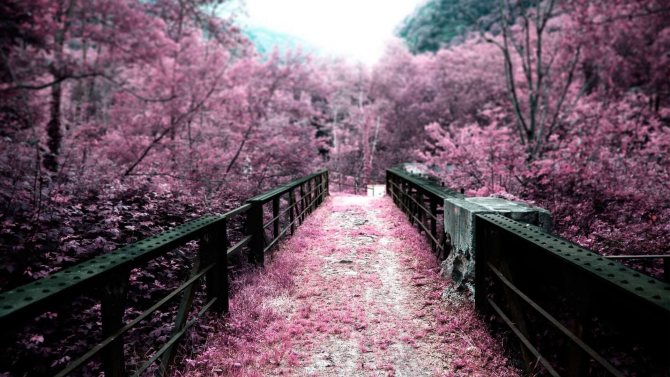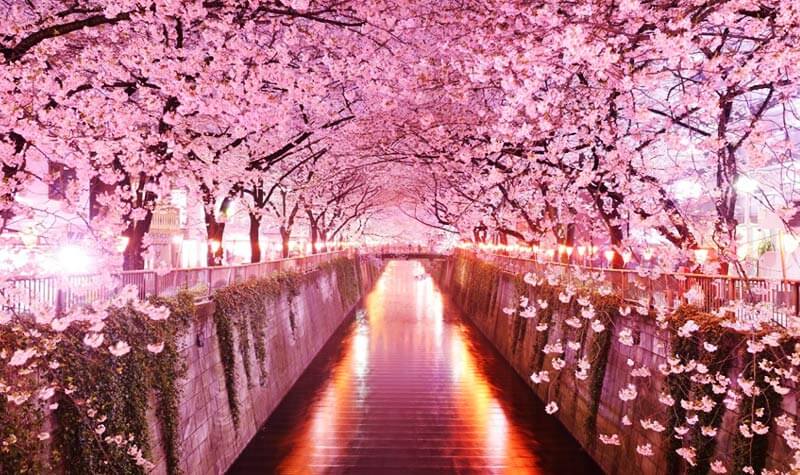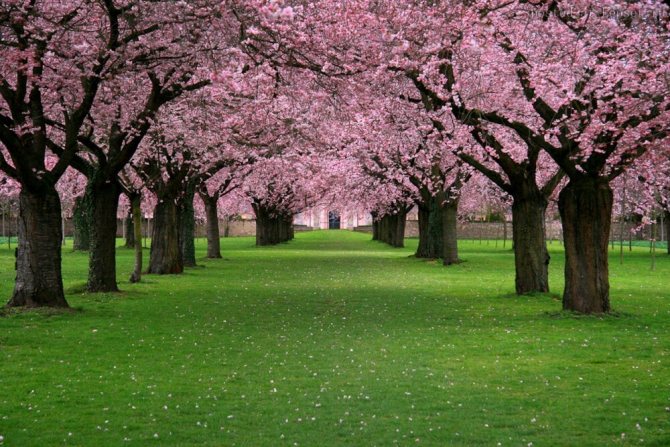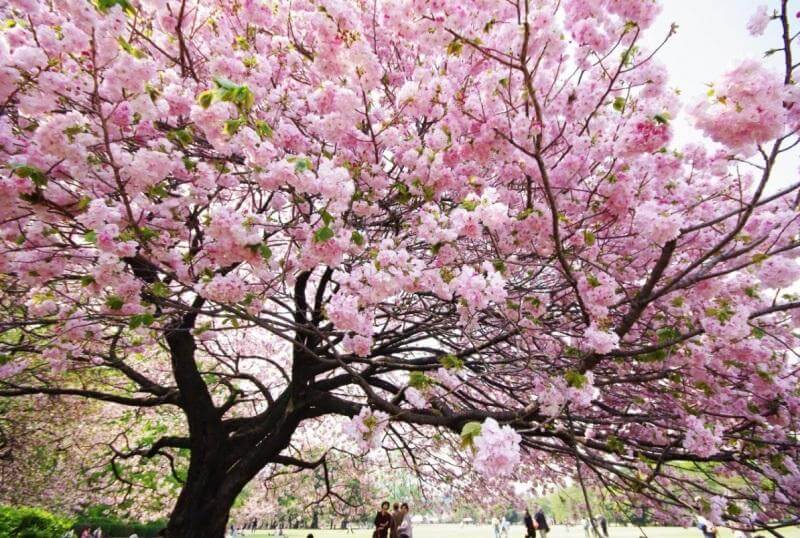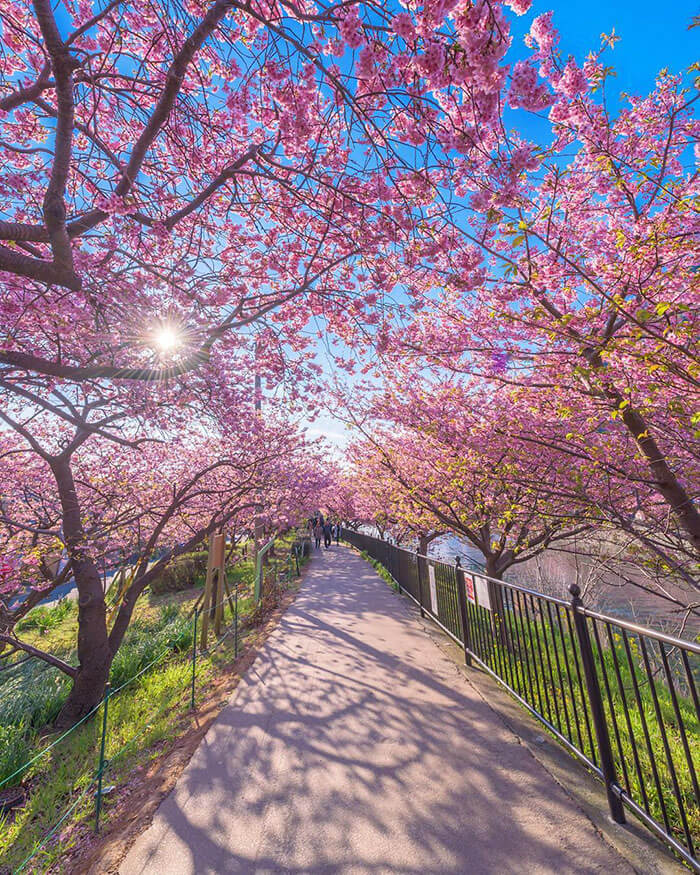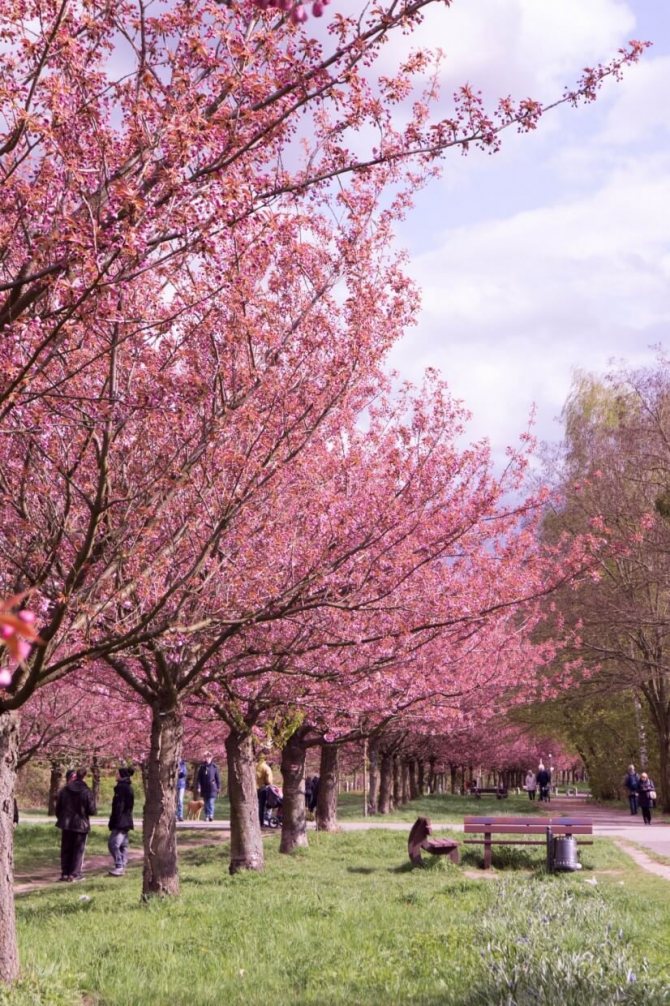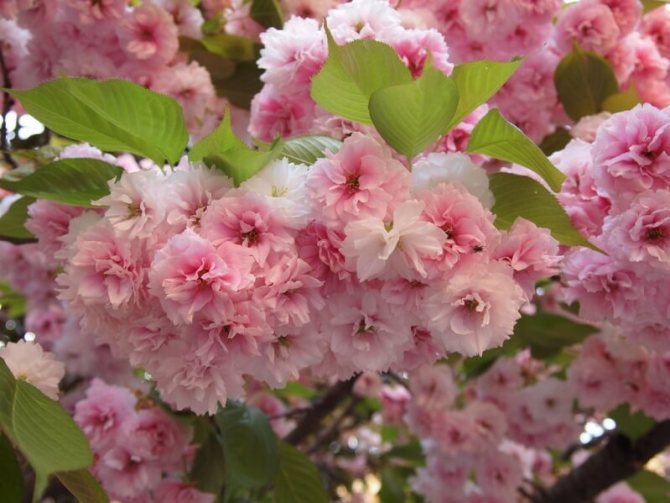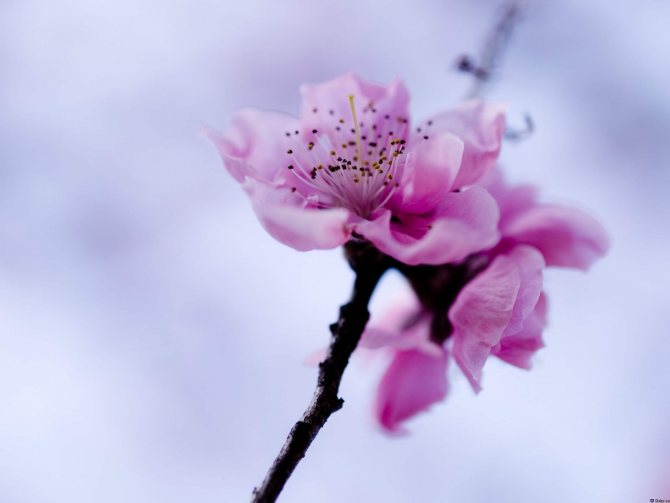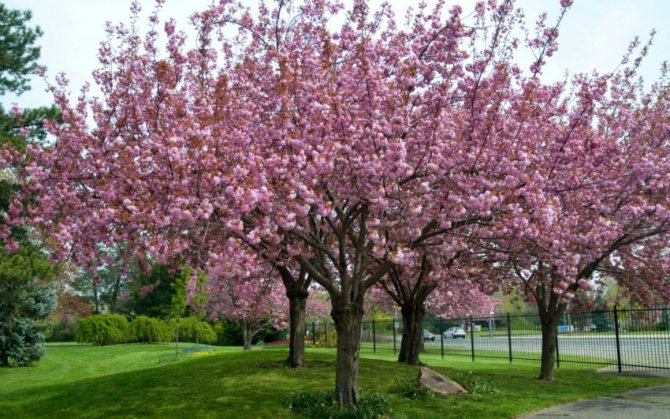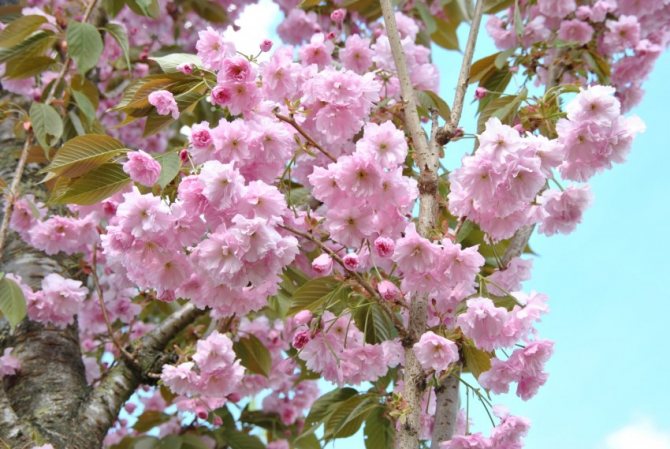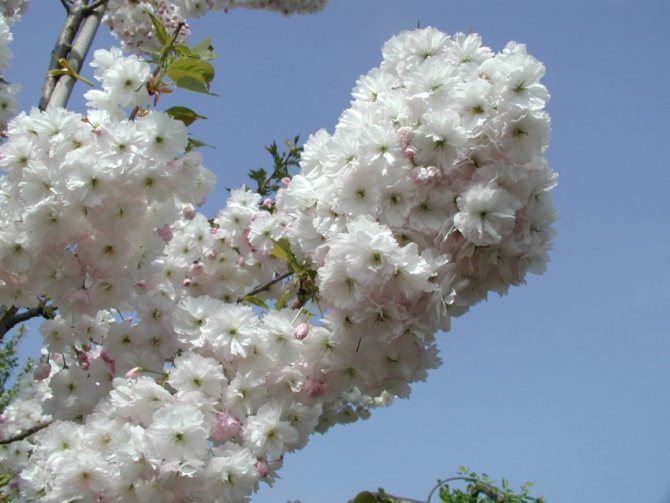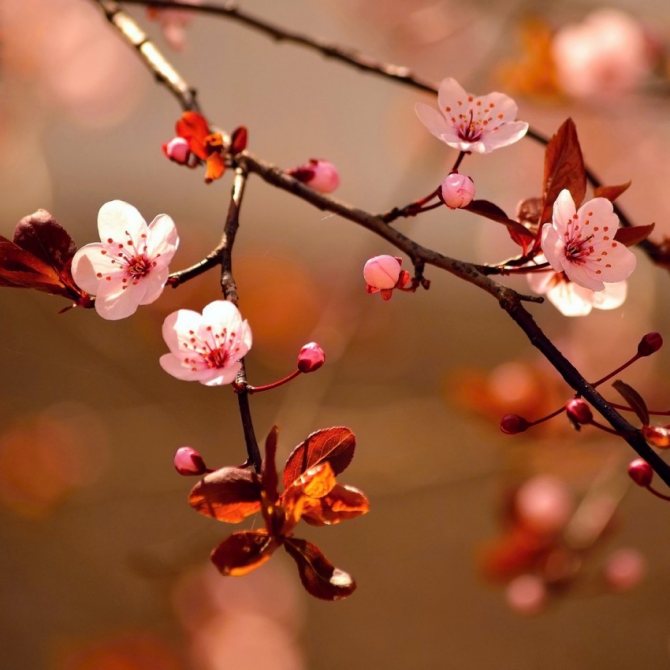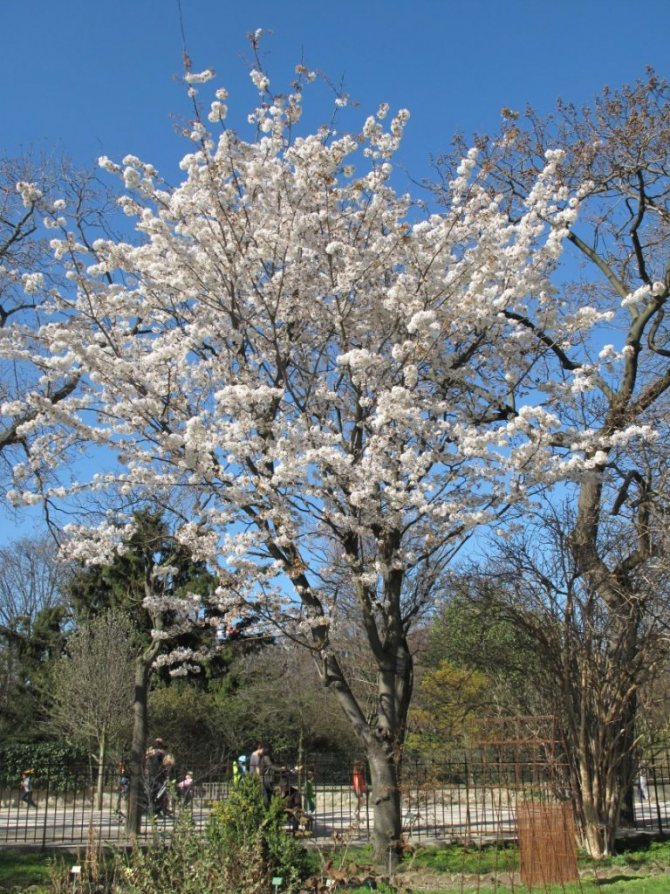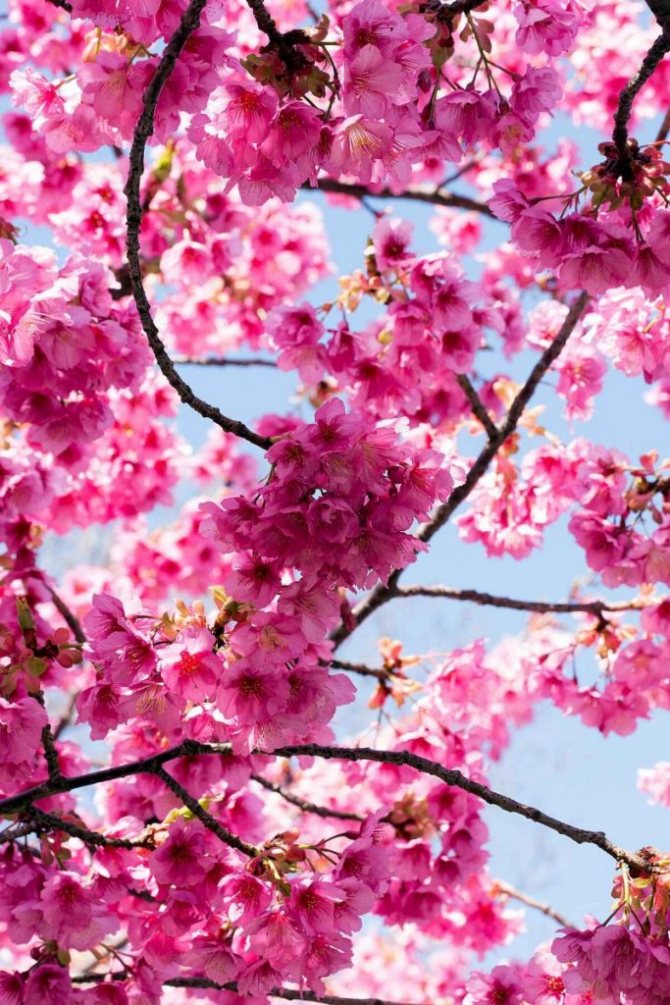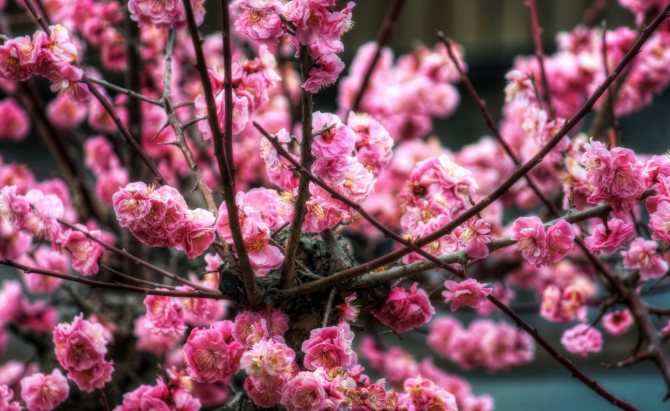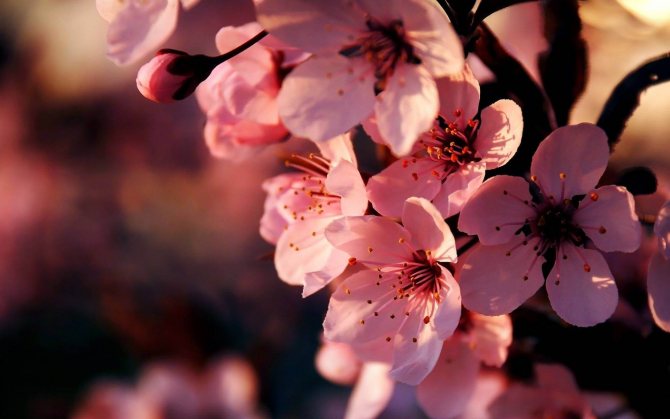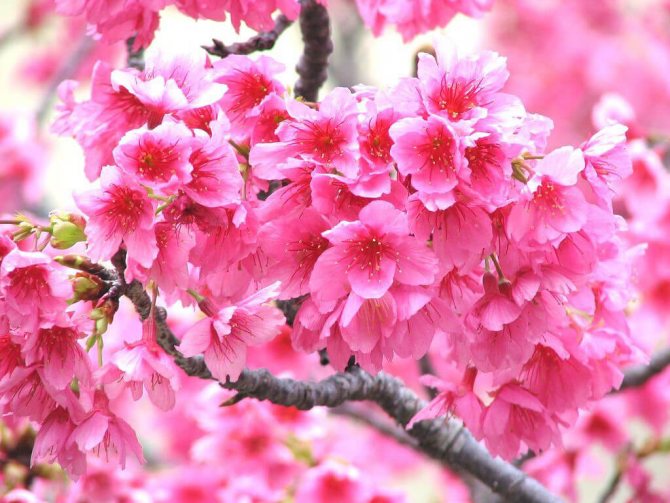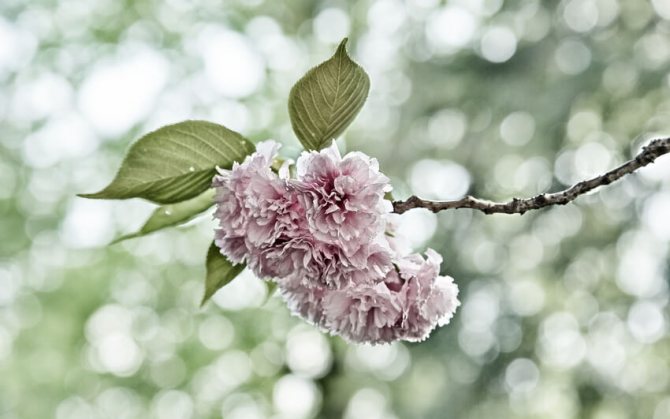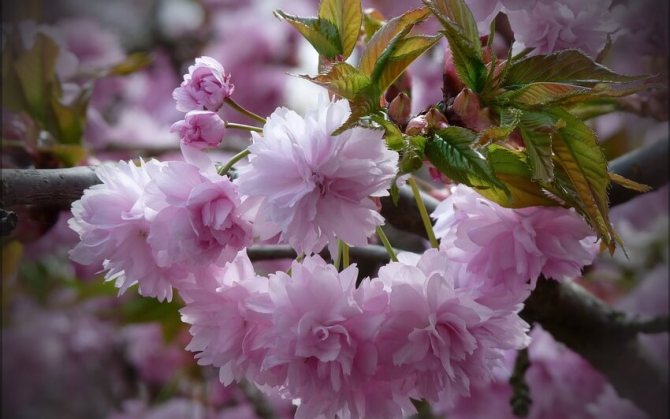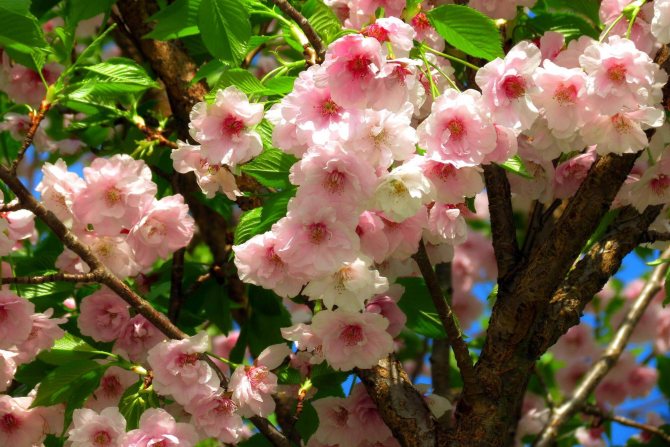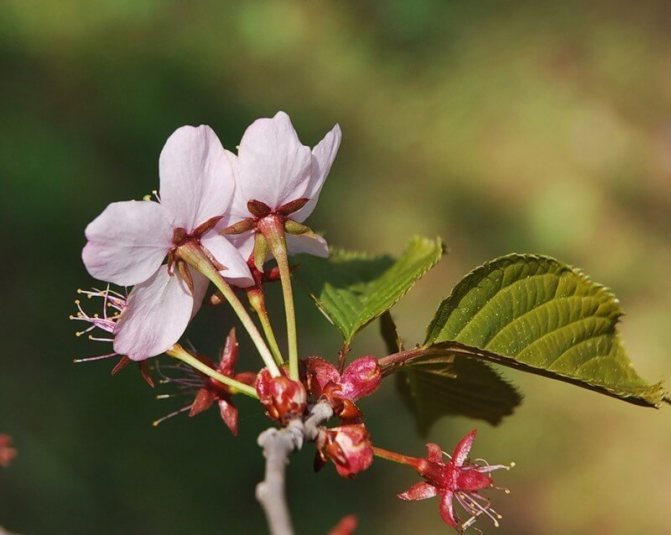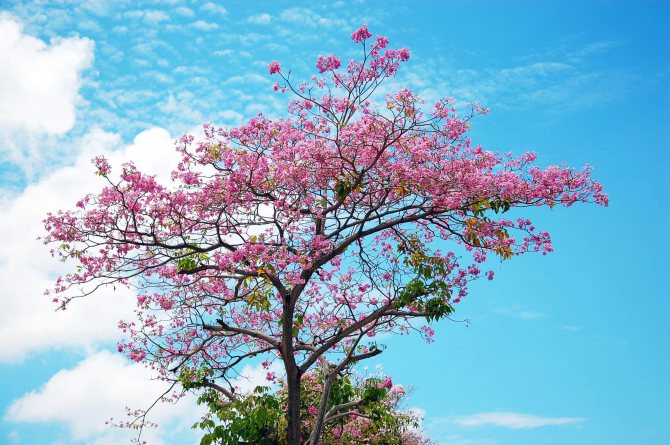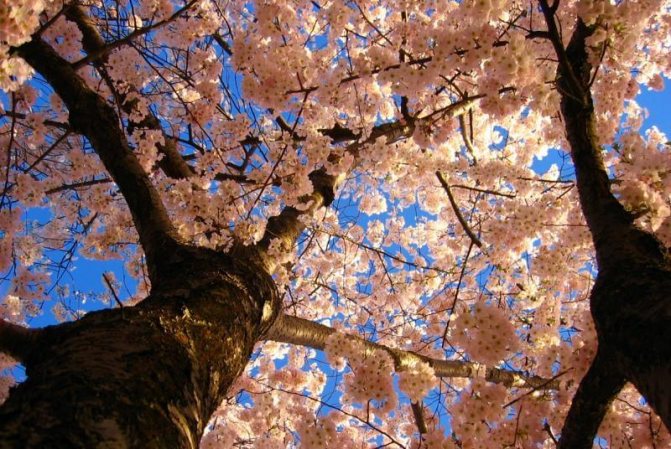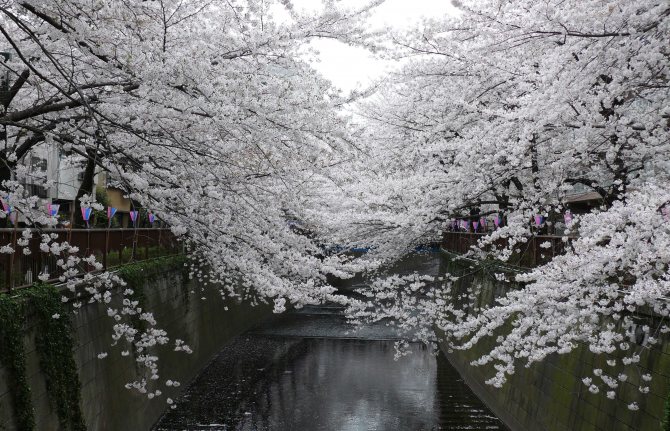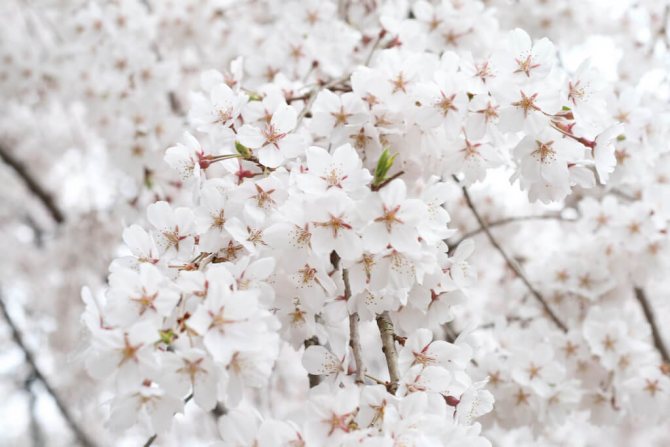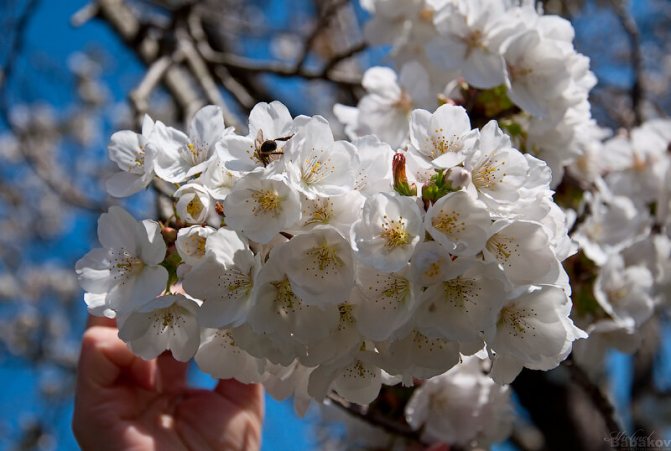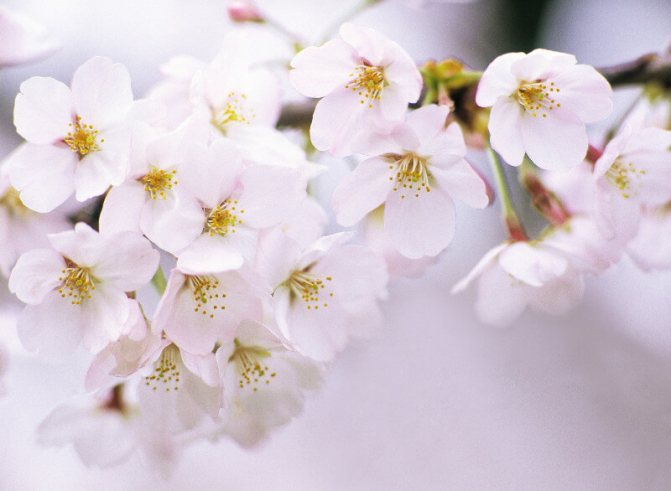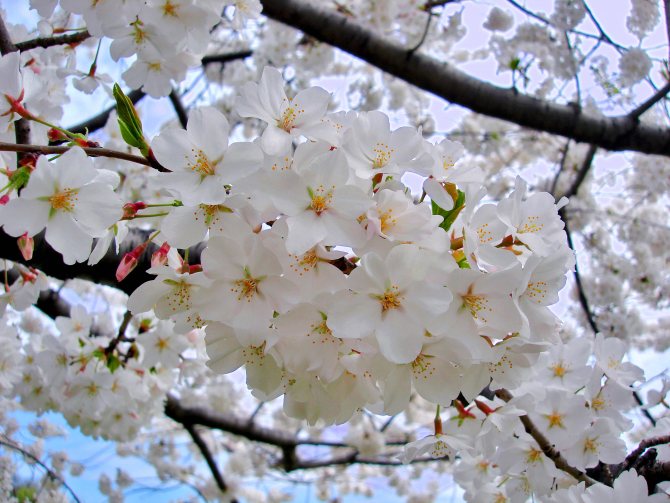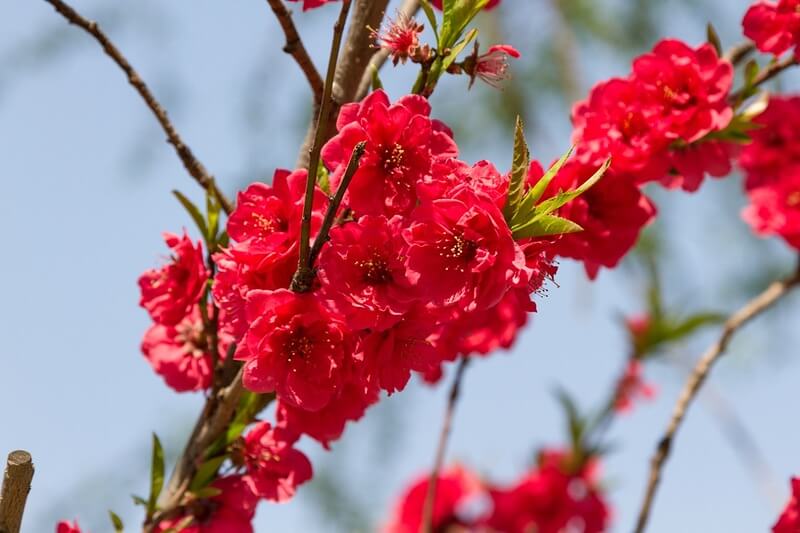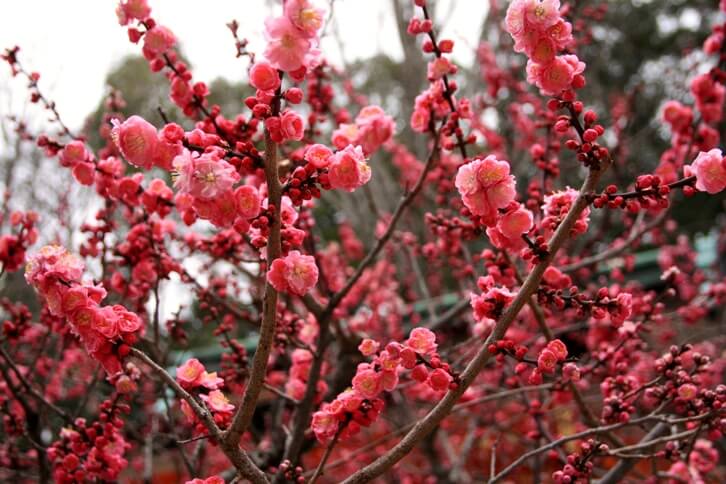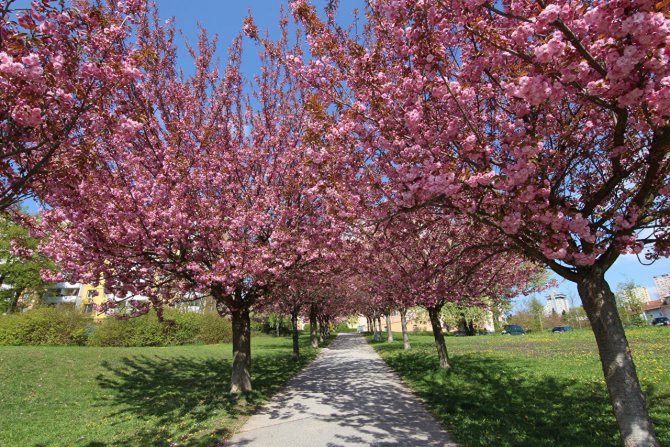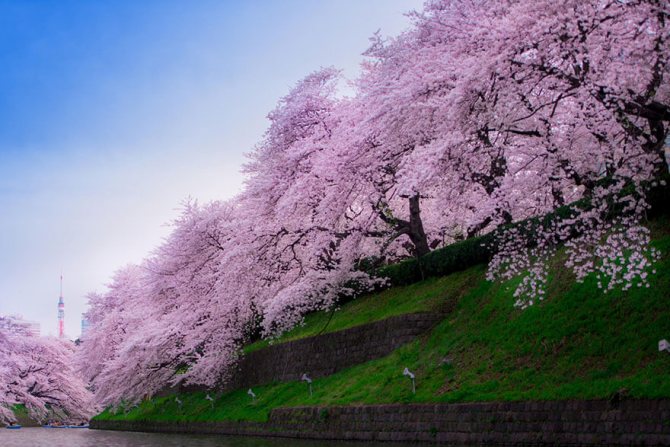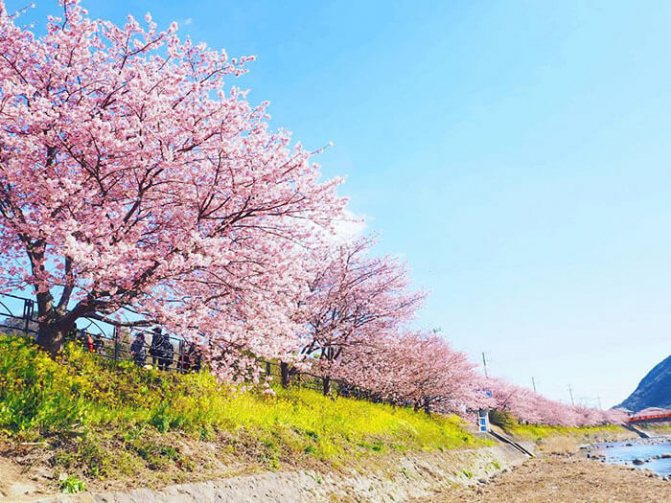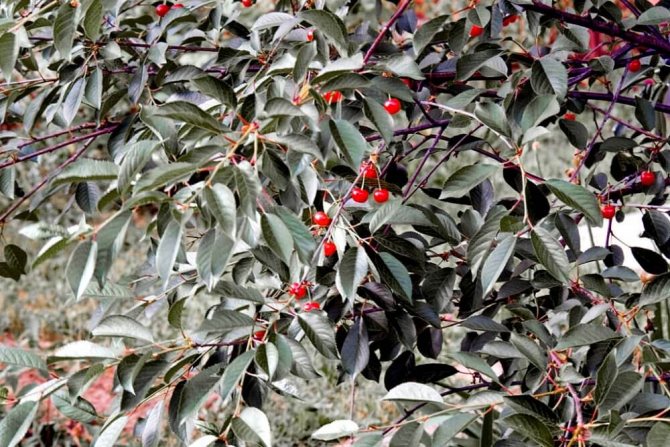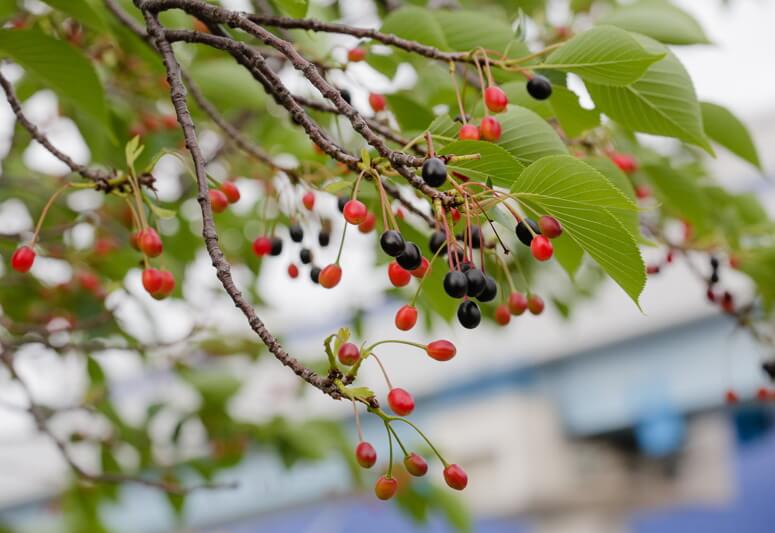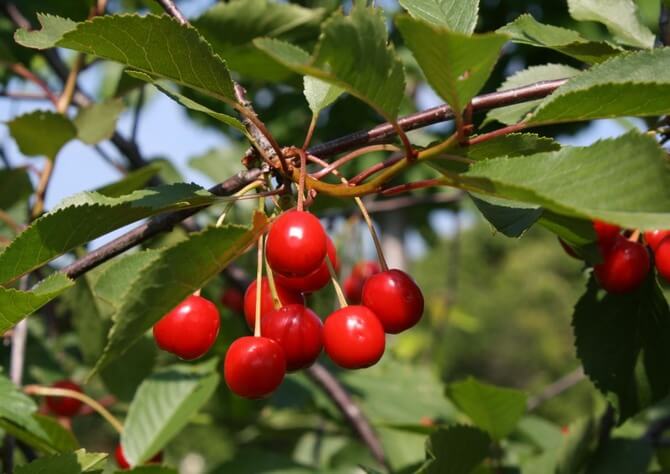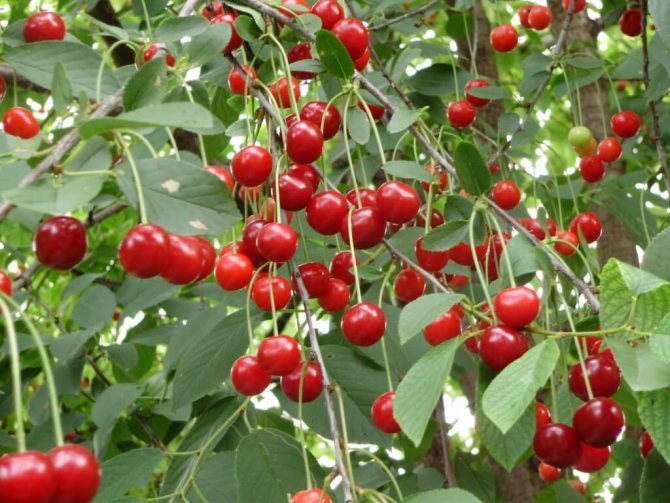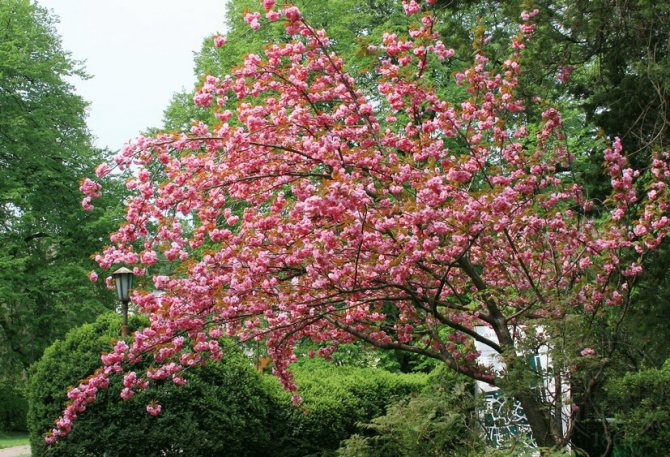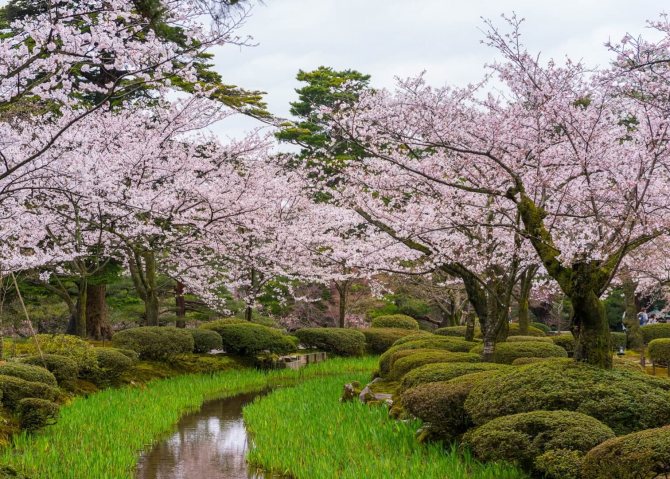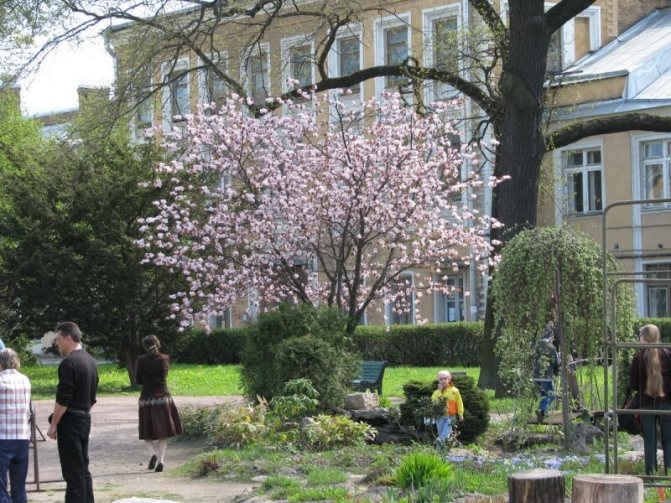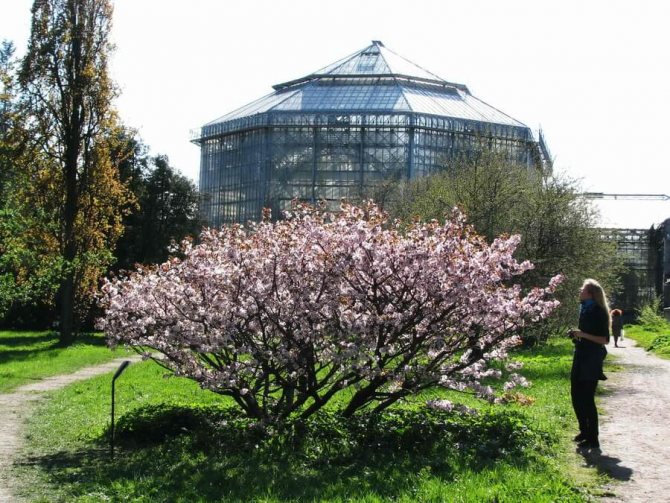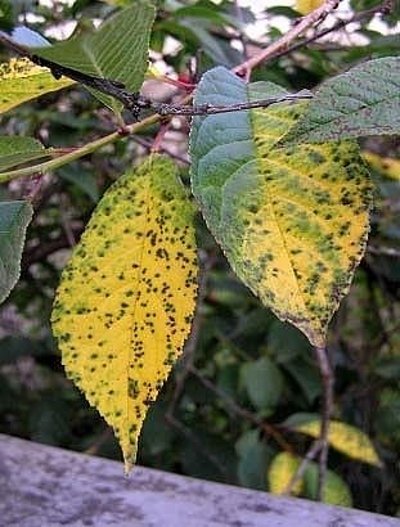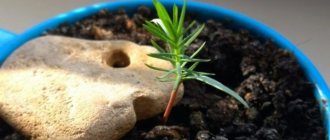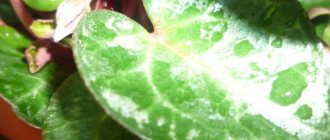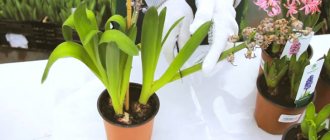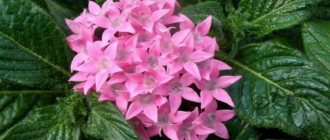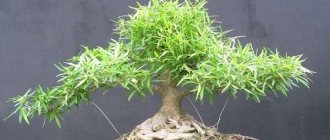Sakura impresses with its exquisite and uniquely delicate bloom. In East Asia, the Japanese cherry is a national symbol that is protected by law. During its flowering, a holiday is organized, where everyone worships a fabulous tree.
In natural conditions, the plant reaches several meters. Many grow miniature copies. Bonsai sakura is an exact copy of an adult plant, reduced many times. It is worth noting that bonsai is the national culture of growing trees in a bowl.
Photo gallery
It is possible that this particular tree has become a symbol of Japan due to the fleeting nature of flowering. Samurai considered sakura a symbol of stamina and purity; they often left hieroglyphs on the trunks in which they praised the sun, nature and the gods. In addition, since ancient times, many poets wrote their poems under this tree, because it was believed that all people standing under the branches of sakura were covered with a divine aura. The principles of Japanese culture are based on aesthetic beauty and grace that only the Japanese cherry blossom plant can match. Sometimes the Japanese compare the picturesqueness and quick death of the flowers of this plant with human death. For this reason, it is believed that the flowers of the Japanese cherry - sakura are the guardians of souls.
Description of the plant
Bonsai sakura refers to ornamental trees that do not require special care conditions. The plant is resistant to dryness of city apartments, gas pollution of the room, watering and lighting.

The Japanese cherry has become a favorite among flower growers due to its amazing flowering. Inflorescences with a diameter of 1 cm tightly frame the branches, creating a monochromatic cloud.
In nature, sakura blooms with bright pink flowers. Breeders have tried and artificially bred plants with a variety of shades.
Hanami: Sakura tree during flowering (with photo and video)
Surely everyone has heard that the Japanese call the admiration of flowers Hanami, but the Japanese did not immediately admire the sakura. According to legend, in 710-790, the main focus of the inhabitants of Japan was on the ume plum trees imported from China. The flowering of this tree aroused delight and affection, if such a plant grew in someone's yard, then it was considered an indicator of wealth. But since 800, the reigning emperor decided to immortalize precisely the cherry tree that grew on the islands of Japan. Thus, the Japanese decided to acquire national identity rather than follow Chinese culture. To encourage Hanami, Tokugawa Yoshimune began to plant sakura. Soon, the Japanese noticed how beautiful their native tree becomes in the spring, when the blossoming flowers acquire an unusual color from bright pink to white.


Since then, the word "flowers" in Japan meant cherry blossom. They soon became a favorite subject for artists and a favorite word for poets. It was even believed that the pollen from the flowers of the Japanese cherry, which gets into the sake, gives the person who drank it strength, courage and health.
What sakura flowers look like can be seen in the photo:
Description
To grow sakura at home probably dreamed, if not everyone, then every second gardener, because this beautiful tree is so pleasing to the eye with its delicate flowering.In China and Japan, as well as in most Asian countries, this cherry variety is much more common than in Russia, and the Asians admire the tree no more than the Russians admire the oak tree. Nevertheless, even in more severe climatic conditions (in the Moscow region, St. Petersburg and even in Siberia) this beautiful plant can be grown. To find out how to do this correctly, we recommend taking note of the tips of our article.
Photo gallery
Today, the Japanese do not stop worshiping their sacred tree. Boutiques, malls and grocery stores are adorned with plastic Japanese cherry blossoms. During the flowering season, specialty foods and drinks appear on the shelves, such as sakura cha and sakura mochi. The first is tea, to which lightly salty sakura petals are added, and the second is rice cakes made from sweet sakura fruits. In addition, in the spring you can buy a special “hanami bento” picnic box, which contains all kinds of snacks, desserts and drinks for the Hanami celebration.
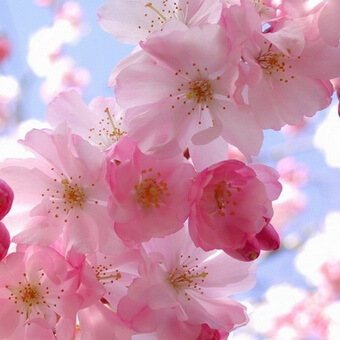

The very same celebration proceeds in a very interesting way. The fact is that high technologies in Japan saturate all spheres of human life. The inhabitants of this country work long and hard, constantly rush somewhere and rarely enjoy life. Only the flowers of the Japanese sakura make the people freeze for a moment and enjoy this extraordinary sight. April is a breath of fresh air for the Japanese, after the annual reports.


One of the most famous Hanami was held in 1598. After the warlord Toyotomi Hideyoshi gained control of the entire territory of Japan, he decided to celebrate by gathering 1,300 people near the Daigo Shrine. This event has been described many times in poems and theatrical performances. A little later, in the years 1650-1800, new seedlings were actively imported into the country to decorate the political center - the city of Edo. At this time, new varieties of Japanese cherry blossoms are being developed, and Hanami is gradually becoming a Japanese tradition.
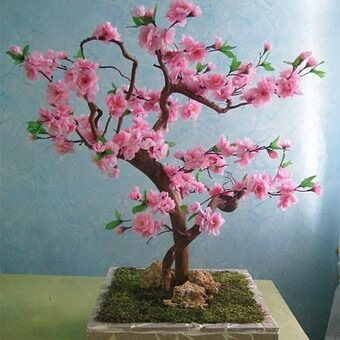

The modern tradition allows the people of Japan to admire sakura not only in the daytime but also in the evening. On radio, television and on social networks, the time of the beginning of bloom is broadcast throughout the country so that people do not miss out on the celebration. The official countdown of the beginning of Hanami is the opening of the first flowers on the tree that grows in the Yasukuni Shrine, located in Tokyo.
Festivals are held in many regions of Japan. Parks are adorned with paper lanterns, street vendors with sweets, children's toys and Japanese traditional food appear in the streets, and tea ceremonies are held under the trees. When the sun goes down, backlights turn on in parks and on the streets, making the bloom look fabulous.
You can see how the sakura tree blooms by watching the video below:
Sakura Tea Ceremony
The tea ceremony in Japan is akin to prayer. Therefore, tea can be considered a divine drink. Mostly the Japanese prefer green varieties of this drink. It differs from Chinese tea in the process of processing the harvested leaves. The most popular teas are Sencha, Matcha, Genmaicha, Kabusecha and others.
Thanks to a special processing technology (with stopping fermentation), sakura leaf tea is one of the most delicious drinks, containing antioxidants and vitamins in their original state.
In addition, they include kakhetians, which endow the drink with special taste and useful properties. This tea is useful for unstable blood pressure and diabetes, to preserve the youth of the body. Tea is packaged in dosed pyramid bags. It brews well, retaining the aromatic notes of sakura and healthy ingredients.
Namacha green tea made in Japan, which contains whole Sakura flowers, has a calming effect on the human nervous system, keeping the body in good shape.They have a curative effect on coughs and skin diseases.
Green tea in tandem with sakura petals has a pleasant aroma and unforgettable taste. Traditionally, the recipe is passed on from one generation to the next, and during the tea ceremony, you can immerse yourself in the hidden corners of the cultural heritage of Japan, feel the unity of the soul with the outside world.
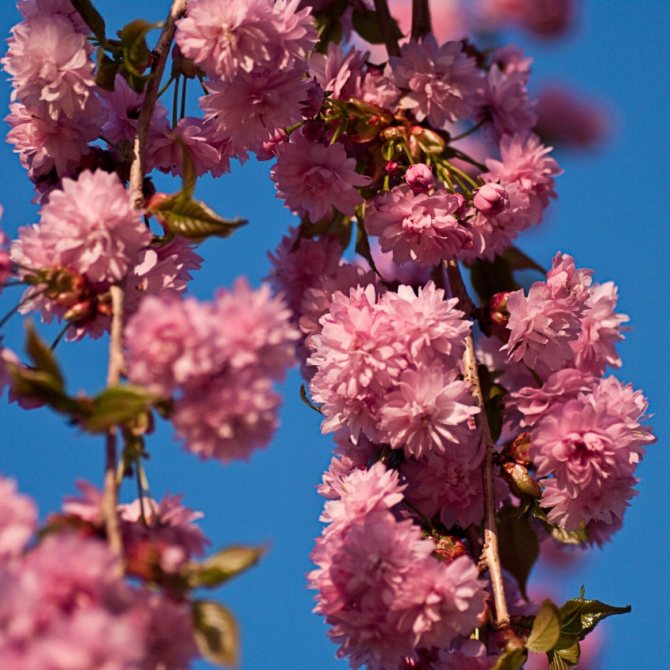

Parks in Japan where cherry blossoms grow
Spring comes to Japan not when the buds begin to open, but when the streets look like a lush garden of delicate pink and white flowers. Beginning in late March, a wave of Japanese cherry blossoms sweeps south of Kyushu in April, sweeps the capital of Tokyo in April, and reaches Hokkaido in May. Therefore, to the question: "Where does cherry blossom grow?", In Japan they answer: "Everywhere." The largest concentration of these trees is observed in Shinjuku Gyoen, Uen and Mitsuike parks. There are over 1000 seedlings here. Over 100 trees can be seen in Tokyo in Kitanomaru and Sumida Park, as well as near the historic Ginkaku-ji and Nanzen-ji temples in Kyoto. It also grows in Sankei-en Landscape Park, the Osaka Mint, Danzakura Alley and many other places throughout the islands of Japan.
Cherry blossoms especially beautifully around castles and sanctuaries. An amazing sight is obtained if the trees are illuminated.
Check out these cute photos of the magical cherry blossoms in the parks of Japan:
Sakura in garden design
Designers use sakura in combination with stones, be it a slide, a wall or a dry stream. Because it grows very slowly, the first years you can grow it in a pot culture. She is good both as a tapeworm and as part of compositions. Even a small tree, only a meter long, will not leave anyone indifferent. But a luxurious pink cloud with a wonderful aroma that has already grown to 2-2.5 meters will be the pride of the owner of the garden.
You will learn about ornamental and frost-resistant shrubs by following the link.
Photo gallery
The most famous and visited in Japan at the time of the Hanami celebration are three places. First of all, this is a national park in Tokyo. There are about 1,500 plants and 75 sakura species here. The festival gathers here hundreds of people who enjoy a picnic under the branches of a beautiful flowering tree. The second most popular place in Tokyo is Ueno City Park, with an area of over 625 square meters. There are 1,100 wild cherry trees growing here, and Hanami is held mainly in early April. Sumida Park is the third famous spot that is famous for its unique lighting.
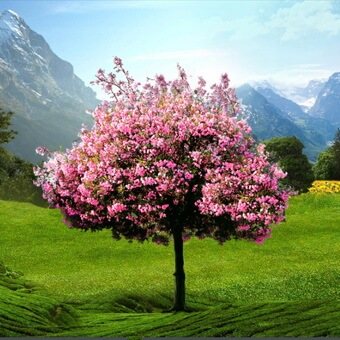

In addition, there are many more places where wild sakura grows. For example, the trees in Takato Park are distinguished by their height, many of which are over 100 years old. The city of Hirosaki has collected in its park 2,600 trees that grow around the majestic ancient castle. In the city of Tsuyama, on the ruins of a Japanese castle among beautiful cherries, various tea ceremonies and music performances are held during the Hanami celebrations. Famous for its pink color from cherry blossoms is the Matsuami Castle in the city of the same name in the province of Hokkaido.
The date for Hanami changes every year, so you need to carefully monitor the media to attend this festival.
Crown formation
It is necessary to pay great attention to the formation of the crown. The structure of the stem and the abundance of flowering depend on this.
There are several rules for pruning:
- First, you need to remove weeds, if any, and dry shoots that inevitably appear.
- If there are crossed branches, they should also be pruned. These are shoots that rub against each other. Thus, they damage the bark, which increases the risk of disease.
- Large branches with side shoots are shortened so that they have no more than 3-4 branches. Otherwise, the growth of the tree will be slowed down.
- In the spring and summer, extensive pruning is carried out, during which it is necessary to give the crown the desired shape.
Reference. During pruning, it is required to use a pruner or a sharp knife, which is previously treated in an alcohol-containing solution. To reduce the likelihood of plant infection, the cut site is treated with activated carbon or hydrogen peroxide.


What sakura looks like: description and features of the types of Japanese cherry
Due to its aesthetic beauty, this plant has gained popularity in many European countries. Although sakura is a Japanese cherry, however, this tree is increasingly common on the streets of European countries. The plant is difficult to confuse with any other species, as it has a distinctive feature - incredible color.
In botany, it belongs to the Pink family. This wild tree grows mainly in the Himalayas, but also occurs in Transcarpathia, Moldova, Krasnodar Territory. The description of a typical sakura tree depends on the species to which it belongs. Distinguish between finely sawed, short-bristled, Sakhalin and ferruginous cherries.
The first type includes most varieties, small-sawed cherry grows up to 15 m in height and has larger leaves. In autumn, they turn into a beautiful purple color and make all passers-by admire themselves. The flower of such a tree is rather large - it reaches 5 cm in diameter. The brush usually contains 7-9 flowers of a double white or pink shade.
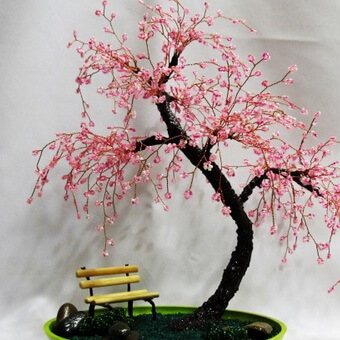

The short-bristled cherry usually does not grow more than 10 m, and its inflorescence contains only 2-3 leaves with a diameter of 2 cm. They have a delicate pink color and appear on the tree even before the leaves appear.
Sakhalin cherry has the most spreading crown and has a height of up to 12 m. A distinctive feature of this tree is the color of its leaves, which turn red in spring and take on a maroon color in autumn.
The leaves of such sakura can be seen in the photo:
Picking
Plant diving is extremely important for the development of the tree. The first pick should be done immediately after germination. Small shoots are planted in 100 ml cups. The substrate is made up of 7 parts of sod land, 3 parts of sand (disinfection, roasting in the oven is mandatory) and 1 part of humus. During the first pick, the root is shortened by 1/3.
The second picking of plants is carried out in 2 months. During the period of work, the root is pinched by 2/3 and the plant is slightly buried. The soil is used with the same composition.
The third pick is carried out after the sakura grows up. But not more often than 2 months after the second procedure. It is recommended to repot the plant when the plant to pot height ratio is 2: 1.
Photo gallery
Flowers up to 3 cm in diameter are initially light pink, and closer to loss they acquire a white saturated color.
A glandular cherry is a shrub that has a height of 1-1.5 m. The flowers have a pleasant velvety texture and have both white and pink colors.
Any Japanese cherry tree makes you admire its flowering with bated breath. It has a huge number of inflorescences of a pleasant delicate color with an unsurpassed aroma.
Look at the photo, how the sakura matches its description:
Step-by-step process of planting seedlings and growing conditions
The planting algorithm for Japanese cherry trees is as follows:
- Dig a hole with a diameter of 40-45 cm. When performing work, do not mix the upper and lower soil layers, since in the future it will be the upper ball for planting that will be required.
- Mix equal amounts of humus, compost and selected soil. If the potting mix is not enough, add regular soil or store-bought all-purpose potting soil.
- Cover the bottom of the dug hole with drainage, using expanded clay, pebbles, fine gravel. Drainage is laid with a layer of at least 10 cm.
- Lay 2/3 of the soil, making a mound in the middle of the pit, and install a support.
- Position the seedling evenly and sprinkle with the rest of the soil, carefully tamping the soil.
When planting, you do not need to deepen the root collar. Make sure that the soil is firmly attached to the roots.
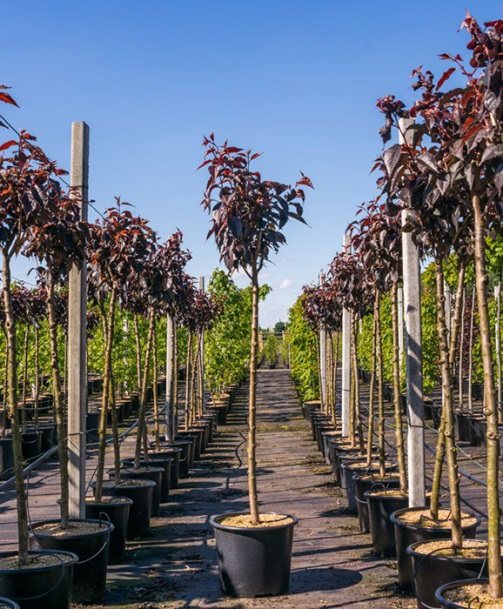

Photo gallery
Common beginner mistakes
Sakura is considered a difficult bonsai to care for. To grow it, it is desirable to have the basic skills of caring for such a crop, obtained by forcing simpler species - myrtle, olive tree, Benjamin's or Microcarp ficuses. Typical mistakes beginner amateurs make:
- excessive watering. Knowing about the dangers of skipping watering, amateurs pour water into the pan, hoping that the plant will take "as much" as needed. As a rule, the tree dies in a week;
- non-observance of temperature and seasonal regimes - feeding in winter and the decision to add lighting with an ordinary lamp. Because of this, in the air, which is already overdried by central heating, the plant suffers more;
- too much wire pulling on the barrel. Crashing into the bark, the wire injures it. The tree suffers such damage painfully.
It should be noted that those who begin to grow capricious bonsai in care cannot do without the death of seedlings. If you analyze the mistakes and learn from what happened, the next time it can be avoided.
Heat-loving and frost-resistant varieties of Japanese sakura
The love of the Japanese for their symbol made it possible to admire more than one variety of cherries. Very often, many people attribute to sakura certain types of peaches, bird cherries, cherries and plums, which have long been united into one genus called Prunus. But later it turned out that cherries have a clear difference. Most cherry blossoms are sawn cherry. There are four types of wild cherry trees in total, and all modern varieties were created by crossing them.


Probably the most beautiful variety is Kwanzan. It is an upright tree with a funnel-shaped crown. The flower contains many petals of intense purple color (about 30), therefore this cherry is considered a richly flowering variety. This thermophilic tree reaches a height of no more than 10 m, and in diameter it can be up to 8 m. The leaves are large enough and reach 10 cm, have a green glossy color. Kwanzan fruits are slightly smaller than regular cherries, but they are no less tasty. The only drawback of this variety is its fragility.
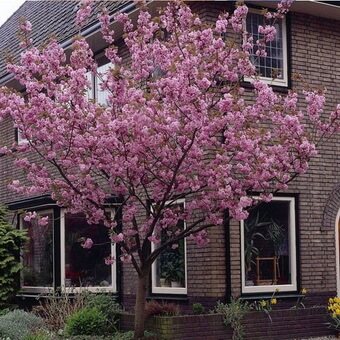

The Kiku Shidar variety can often be heard under the name “weeping cherry”. The height of such sakura reaches only 5 m, and its diameter can be up to 4 m. The leaves resemble an ellipse and are green in color. The branches hang down in an arc, and the crown itself is irregular and looks like a funnel. Sakura flowers of this variety grow very densely, located along the entire branch to the very bottom. The fruits of such Japanese sakura are small in size and slightly sour in taste.
Shiritai is an equally famous variety. Oddly enough, the birthplace of this cherry is England. Many attribute it to the representatives of a typical village cherry; a typical plant reaches a height of no more than 4 m.
The Shiro-Fugen variety attracts with its rich, double-flowered white flowers. Its height reaches 10 m, and the color of the inflorescences gradually acquires a delicate pink tint.
A delicate white color is also characteristic of the Tau Haku variety, which was discovered in England only at the end of the 20th century.
In the photo you can see the white color of the sakura plant:
WHAT IS SHE - FROST RESISTANT SAKURA?
Northern Sakura, as a rule, is a short tree, up to 3.5 m high, with large double flowers of pale pink, crimson, lilac or white. In general, the classic sakura flowers are dazzling white, up to 6.5 cm in diameter.
There are a lot of flowers. They are collected in large clusters of 8-10 inflorescences, completely covering the branch. As a result, the entire crown looks like one white or pale pink ball, behind which the leaves are not visible at all.
Flowering begins in May and can last for a very long time, and it's just a miracle. The most beautiful, frost-resistant and long-flowering - sakura Taihaku.
In addition to all other advantages, she practically does not get sick and is not affected by pests and is considered the most unpretentious to care for. Even a novice gardener can grow this sakura!
Sakura is a long-liver. It can grow in one place for over 500 years. Flowering begins in the third year. The flowers exude a wonderful aroma and attract a huge number of pollinating insects to the garden.
Sakura leaves in spring have a golden-bronze color, and by the middle of summer they change to dark green. The bark of the tree is smooth, grayish-pink with thin cracks.
The wood of the tree contains a large amount of resin. Therefore, its branches are very flexible, drooping, perfectly amenable to forming.
When growing sakura, keep in mind that it grows slowly. That is why her annual seedlings are often planted in bonsai-style gardens along with dwarf pines.
Sakura does not take root very quickly, so it should be planted in spring or early summer (plants with a closed root system) so that it takes root well before autumn and has time to prepare for winter frosts.
Photo gallery
The Kikishidare tree has a very beautiful flower color, which gains a height of up to 5 m. But its main disadvantage is its inability to withstand frost.
No less popular is the Amanogawa cultivar, which is not like other sakura cultivars. The fact is that this tree reaches 8 m in height, but at the same time its width is only about 1 m. The flowers have a divine scent and cover the branches very densely.
Hali Tolivet is a very unusual variety, which has a spherical crown. The diameter of pink inflorescences reaches 4 cm.
To frost-resistant - include the following varieties of Japanese sakura:
Kwanzan.


Kiku Shidar.


Hali Tolivet.
Each variety is beautiful in its own way, you can admire the flowering of these trees for hours, inhaling their divine aroma.
All four types of sakura can be found in the photo and see how they correspond to their names:
Choosing a landing site
Sakura is very fond of abundant diffused light. The best choice of location is the southwestern slope, the slope of which does not exceed 10 degrees. The place should be quiet, protected from drafts, and well lit. The plot in the country is chosen elevated or a hill is created artificially (by filling the soil). Sakura should not be planted in the lowlands, as it will dry out quickly. Planting a plant in the south of the site will cause the sun to "burn" the plant.
For long flowering, it is worth planting several varieties.
The plant is especially demanding on the composition of the soil. Prefers neutral soil. Preference should be given to light loam. If the soil is heavy on the site, it is recommended to add a component - a baking powder - sand, perlite, vermiculite.
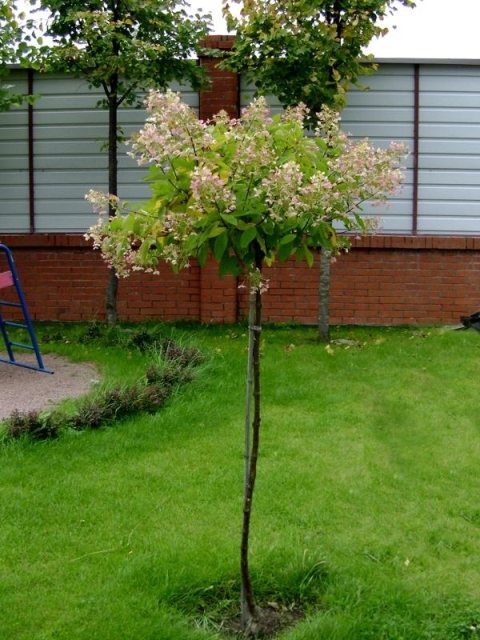

Photo gallery
Departure Point: Cherry Pit
A luxurious overseas guest is capricious and whimsical in cultivation, but, nevertheless, is increasingly found in our gardens, parks, city squares.
As befits a cherry, a Japanese beauty grows from a cherry fruit seed. The long journey of turning a small cherry seed into an adult tree is not the easiest, but the end result is worth the effort and time. It starts, of course, with the purchase of planting material.
If you have an adult fruiting Japanese cherry in your field of vision (from friends or in your own household), you can stock up on seeds from it by collecting ripe fruits and freeing the seeds from the shell. Another option is to purchase ready-made seeds from an online store.
Sakura seeds
The species diversity of cherry blossoms is quite large, while not all varieties take root in the Russian climate. Our winters tolerate such sakura varieties without any problems:
- Kikushidare - 3-5 meter double-flowered tree
- Kwanzan - with large purple flowers
- Spire and Shidare Yoshino are specially bred frost-resistant varieties that can withstand temperatures down to -30 degrees
- Halle Olivetti - also a frost-resistant species
Thanks to the selection and breeding of new varieties, today there are frequent cases of successful sakura cultivation even in Siberia.
Before planting in the soil, the bones should be soaked in warm (30 degrees) water for a day. It would be nice to add fungicides or growth stimulants to the liquid - additional protection for capricious fruits will not be superfluous. The outer shell of cherry seeds is very hard, therefore, to facilitate germination, you need to carefully prick or cut the shell, but in no case damage the inner part.
On a note! Sakura seeds do not germinate well, so they need to be planted "with a margin", taking into account potential losses (even only 20 percent germination of the material is considered the norm).
After soaking for a day, the bones are ready for further procedures.
Planting and picking seedlings
Sakura loves slightly acidic loose soils, the ideal option is coarse sand. You can slightly dilute it with compost, wood ash. The soil, in order to avoid seedling diseases, must be calcined.
The container for disembarkation must be shallow, always with drainage holes. The seeds are buried in the sand by about a centimeter, with a three-centimeter distance between them. On top, you can pour a half-centimeter layer of fine sand, and cover the container with foil.
The answer to your question: the best time to plant seedlings is spring (after the last frost) and late summer - early autumn.
Then the planted seeds undergo cold stratification: the temperature should be 2-4 degrees, the period should be two months. The bottom shelf of the refrigerator is considered the best option. Two months later, the box with seeds must be taken out, and then the seedlings must be germinated in room conditions. It is necessary to monitor the constant moisture content of the soil and a sufficient amount of indirect sunlight. Seedlings usually appear in one and a half to two weeks. With the emergence of shoots, you can slightly raise the film so that more fresh air flows inside.
Sprouted seedlings are immediately planted in separate pots or in a larger common dish, leaving a 10-centimeter distance between the shoots. The pick "trains" the root system, so the seedlings are transplanted annually - in spring and autumn, excluding the winter period. With each transplant, plants need to pick up more spacious pots and apply humus to the soil (or feed them with special fertilizers from April to September).
Destination: a place in the garden
Two-year-old seedlings are ready for planting in open ground. To do this, a planting hole is dug with a diameter of about 35-40 cm, a depth of 40 cm. Drainage is poured at the bottom (pebbles, crushed stone, etc.), the earth from the pit is carefully separated from stones, roots, and the like and covered with drainage up to half the height. The seedling itself is planted in a mixture of humus, compost, sand and field soil.
Planting rules are standard for all tree seedlings: trample the ground, water, fill up the top layer, make a watering ditch around the trunk. The thin stem must be attached to the retaining post.
Planted trees still require careful maintenance: they need to be watered, avoiding overflow, weeding, loosen the top soil layer, wrap them up for the winter. In the spring, when flowers and leaves are formed, nitrogen-potassium feeding is required.
Just 3-4 years after planting seeds in pots, young sakura in the garden will already delight with annual flowering, continuing to grow. An adult tree blooms with bright and fragrant flowers for about a week every spring, in autumn the sakura is also picturesque - the foliage acquires a yellow-purple hue.
Sakura-no-mi or sakurambo: the fruits of the sakura plant and their photos
In addition to the beautiful pink bloom and stunning colors that sakura leaves can shine with, it has quite tasty fruits. Although many people still consider the Japanese cherry exclusively an ornamental plant. In addition to aesthetic pleasure, this tree gives small, but quite tasty berries.
The fruits of the Japanese sakura are called sakura-no-mi. Due to the fact that the berries do not have a sweet enough taste, they are most often eaten together with marinade. Wine made from the fruits of the Japanese cherry is no less tasty. In addition, they are often added as a seasoning to rice.
Sakura fruits are clearly visible in the photo:
Features of seasonal care
Japanese cherries are not at all prepared for the winter season. She tolerates the cold extremely hard, which is why it is necessary:
- At the end of summer, apply potash and phosphorus fertilizers. It is strictly forbidden to use complexes with nitrogen content.
- A few days before the expected first frost, cover the trunk and grafting sites with agrofibre.
When sheltering, do not use plastic wrap, as it does not allow air to pass through and leads to rot.
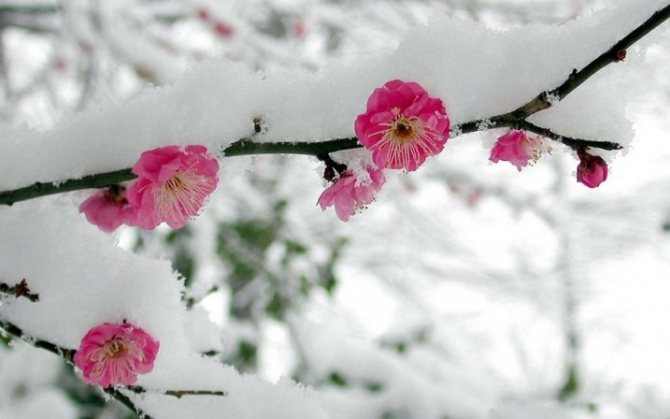

Photo gallery
There is another name - sakurambo, but this plant has nothing to do with the Japanese symbol, but rather a commercial move. The trick is that enterprising people brought varieties of ordinary cherries to Japan, which are exported as true berries of Japanese cherries.
However, other parts of the cherry tree are also used in food. Very often, Japanese sweets are wrapped in the leaves of the real sakura tree. In addition, there are lovers of pickled leaves, their salty-sweet or sour flavor goes well with rice.
Harvesting and storage
Sakura is not grown for the purpose of harvesting. This is an ornamental plant that will become the hallmark of the suburban area. And yet, if the sakura variety has pleased with the fruits, they are harvested after full ripening by hand. Eat fresh. Still, cherry blossoms are very, very sour. Only a few people like their extravagant taste. In the homeland of growth, tea made from sakura leaves and flowers is valued. The plant is rich in natural antioxidants, namely kakhetins - effective body cleansers.
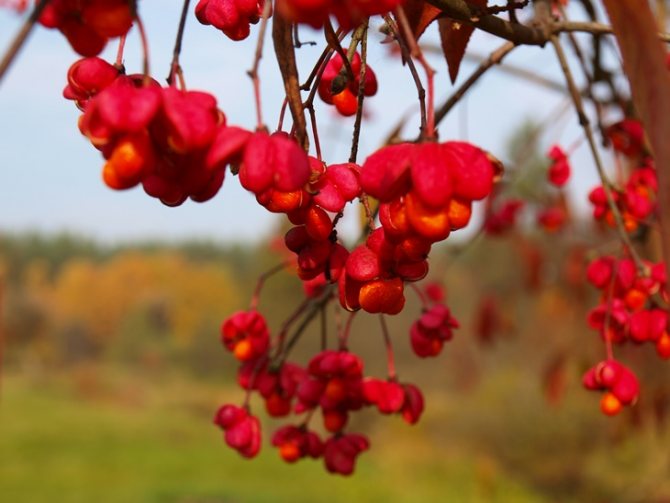

Sakura is a plant with a long history. In Japan, she is worshiped. On the coats of arms of state institutions, its flowers take pride of place. It is worth planting sakura in your own summer cottage because of its sophistication and perfection.
What sakura tree to plant in the yard?
Today, everyone can independently choose which Japanese sakura tree to plant in the yard. This plant is gaining more and more popularity every year, and therefore there will be no problems with its purchase. But depending on weather conditions, it is better to give preference to frost-resistant varieties.
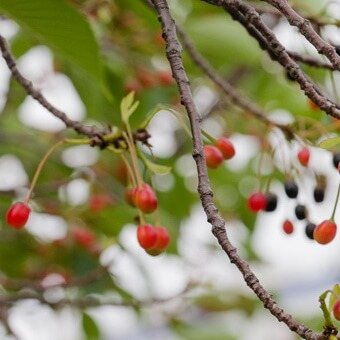

Reproduction of Japanese cherries most often occurs by seeds. The best time of the year to plant is summer, when it is warm enough outside, but not too hot. For this reason, some people plant sakura in early fall or late spring. It is very important that a place with optimal sunlight is chosen for the tree, and it does not get burned. Such a place should also be protected from strong winds. Loamy soil is ideal as a soil. If the soil is heavy, you need to add a baking powder to it, for example, treat with manure, add sand or compost.
You can propagate Japanese cherries by seedlings, but for this you need to pay attention to some factors:
- the plant is native to the northern islands of Japan, for example, Hokkaido;
- it is better to choose two-year-old seedlings with a height of 1 m;
- it is more prudent to buy seedlings after the summer, when they no longer have leaves.
To understand which varieties of Japanese cherry blossoms are suitable for the region in which it is planned to plant it, it is enough to carefully study the catalogs of nurseries. Most likely, it will be Sakhalin and finely sawed cherries.It is best to focus on the Amanogawa and Kanzan varieties when it comes to small-sawn cherries, buy Autumnalis, which belongs to short-bristled cherries, or choose Alcoleid, Edwin Mueller or Wool Murasaki varieties if you want something from the Sakhalin cherry species. It is the last variety that is not afraid of large frosts and has a fairly early flowering. Its great advantage is also disease resistance. It is better to decide on the preferred types of Japanese sakura when you can see what sakura looks like. For this it is worth visiting the nurseries.
How to properly prune bonsai sakura
To grow a miniature culture, experts use various tricks and techniques. The task is to make even a young tree look like a hundred-year-old tree. For this:
- Expose some of the roots by removing a small layer at the base of the trunk. He must be fat. To do this, regularly remove all vertically growing shoots.
- The barrel should not be too long. Cut off a portion of the root at its base. When replanting, deepen the cut into the ground. Over time, new roots will grow on it. Then the tree can be dived again, while removing the old rhizome.
- The most massive branch of the tree will be the bottom one. What kind of escape to leave for its formation - decide on the basis of the compositional idea.
- For a broom-shaped crown, cut vertically growing branches to the maximum. For vertical, on the contrary, protect vertical branches. In this case, only horizontal ones are cut.
All these manipulations are needed by the bonsai tree constantly. Otherwise, it will lose its shape. The gardener's goal is to maximize the decorative effect of sakura. If you adhere to the cultivation technology, provide the plant with a little care and attention every day, then the Japanese guest will delight you with a lush, large and bright color every spring.
Sakura care
Sakura does not require any special care, but the branches need to be cut more carefully. For example, young trees only need sanitary pruning.


The best prevention against gum disease is:
- top dressing - it is produced with organic or mineral fertilizers, as well as by using manure, humus, phosphorus, potassium and nitrogen;
- watering - it should be plentiful only during the ovary period;
- timely spraying from diseases, during flowering, processing is prohibited;
- tie the headquarters and cover the trunk with agrofibre before the onset of frost.
The Japanese national sakura tree is also grown by some for fruit picking, but mostly it serves as a great way to enjoy the beauty of nature. Unfortunately, this tree blooms only once a year for no more than 10 days. Many tourists are ready to come to Japan for the sake of this spectacle, and there are people who are ready to do a lot to plant sakura near their house and pamper themselves every morning with an unrivaled view of its white-pink color.
Look at the photo of how magnificent the garden is during the Japanese cherry blossom season:
How to care for a tree
Sakura is much more demanding than ordinary cherry. In addition to controlled irrigation, it must be sprayed. But this procedure should be carried out very carefully, since the root system of the Japanese cherry quickly decays. Care instructions:
- In the spring, sanitary thinning of the crown is carried out. A very sharp knife will be used. Sakura - painfully tolerates any mechanical damage, which is why it is worth treating the cuts with garden disinfectant varnish.
- Many varieties are not resistant to infectious diseases, and therefore the use of fungicides is simply necessary. The first treatment is carried out at the time of swelling of the kidneys, the second - after the ovary.
The gardener must pay due attention to the young plant so that it pleases with an impeccable appearance, exquisite flowering and fruiting.
Watering features
The plant should be watered after the top layer of the soil dries.It is especially important to water the plant during the period of bud swelling, at the time of bud flowering. After watering, it is recommended to loosen the soil surface.
Top dressing
Fertilizers are applied at the time of watering. The plant needs organic matter, compost, minerals. Nitrogen and potassium must be introduced without fail. Complex ready-made fertilizers, which can be bought in a specialized store, are also suitable. In the fall, sakura is fed with nitrogen-free nutrients. The annual rate of application of organic fertilizers and compost is 10 kg, minerals - 15 g.
It is not recommended to use preparations that can affect the acidity of the soil.
Shaping and pruning
Sanitary pruning of the crown or its formation is carried out before the start of sap flow. Having violated this rule, gum flow occurs - the release of resin from the "wounds", which leads to the weakening of the plant. The first years after planting, it is not advisable to form the sakura crown. Sanitary trimming is done only as needed.
All cuts are compulsorily processed with garden varnish!


Photo gallery
Sakura from seeds: preparation for planting
The basis for growing any crop is high-quality seed. Sakura seeds can be purchased at specialized retail outlets. Seed germination is poor - no more than 20%. On this score, gardeners advise:
- buy more stuff;
- use products from different manufacturers to determine who has the best quality.


The process of planting a tree requires the following actions:
- Stratify. For seeds, simulate natural winter weather. To do this, put them in a bag of wet sand and place them in the warmest compartment of the refrigerator. At a temperature of + 4 ... + 5 ° C, the material should be stored for at least 2-3 months.
- A couple of days before planting, soak the seeds for a day in lukewarm water.
- To help the seedlings break through the seed coat, mechanically scratch or puncture the outer layer.
Sakura seeds are planted in coarse sand that has been calcined or otherwise disinfected. Such a substrate is most suitable for germinating seeds and, in addition, will protect the culture from diseases. An alternative to sand is moss or vermiculite. Use a wide, shallow container as a pot. Drainage holes are required.
16 excellent varieties of plums for the Moscow region
What does it look like
Few people know that sakura is the "sister" of cherries, namely, finely sawed cherries. Speaking about what sakura looks like, it is worth imagining not a copy of our cherry, but a tall tree with a spreading crown, which on average reaches a height of 8 meters. It has oval leaves, with denticles on the edges, which are painted in glossy green color (in spring they have a bronze tint). The bark is smooth, covered with fine cracks.
Read also: Poltava breed of chickens - description, content, photos and video
It is interesting that there is a lot of resin in sakura wood, so the shoots are very flexible.
The three-lobed almond and the Nedzwiecki apple tree also boast a sophisticated pink bloom.
Beautiful legend
To begin with, let's talk about a beautiful legend, according to which the veneration of sakura arose. The Japanese have an opinion that the flowers that bloom in early spring are the fate of children. A long time ago, the foreman of the village brought his children to the ruler and showed him the scars on their backs, which appeared due to the cruel treatment of the prince's servants. It was a very brave act.
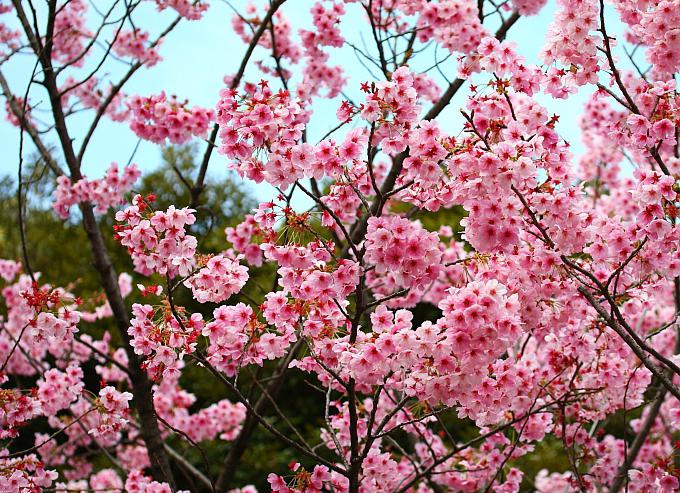

The ruler punished the prince, and he harbored a grudge against the foreman. He took his family high into the mountains and tied them to a cherry tree. Then they were whipped to death. Since then, cherry blossoms in Japan are said to have a pink tint. This is the answer to the question "Is Sakura cherry or plum?" For those who know this legend, falling petals plucked from the sakura by the wind cause sadness and sadness.
How to grow bonsai sakura from seeds at home - step by step instructions
Sakura impresses with its exquisite and uniquely delicate bloom. In East Asia, the Japanese cherry is a national symbol that is protected by law. During its flowering, a holiday is organized, where everyone worships a fabulous tree.
In natural conditions, the plant reaches several meters. Many grow miniature copies. Bonsai sakura is an exact copy of an adult plant, reduced many times. It is worth noting that bonsai is the national culture of growing trees in a bowl.
How to plant and dive sakura at home
Correct planting is half the success of the future sakura cultivation:
- treat the seeds with a fungicide;
- moisten the substrate;
- deepen the seeds by half a centimeter into the grooves made (there should be at least 3 cm between them);
- cover the planting with a thin layer of fine-grained sand;
- cover the pot with foil or glass;
- leave at a temperature of + 5 ... 10 ° C.
Attention! Gardeners recommend planting seeds in the spring or at the turn of August and September.
Seedlings should appear in 1.5-2 weeks. Up to this point, care consists in maintaining the top layer of the soil in a moist state, providing a large amount of light, and gradually raising the temperature to room level. Shoots appeared - dive them into separate pots. The distance between the planted seedlings should not be more than 10 cm if you move them to a new common container.
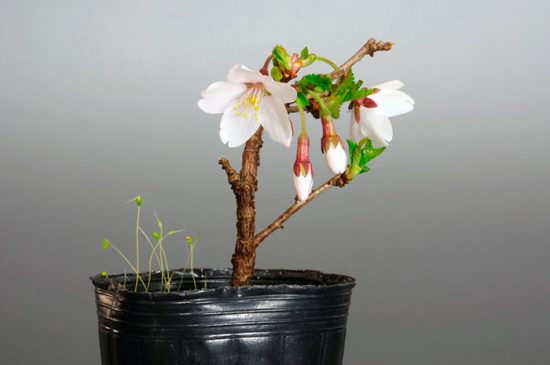

A pick is an important condition for the normal development of sakura. Multiple transplants strengthen the root system. Sakura seedlings are not touched only in the cold season. They are placed in a cool, shaded room until spring. The key point in picking up grown seedlings is the selection of new pots. The gardener has two options:
- leave the culture to grow in a cramped container and form a bonsai version of the tree;
- move it to deeper and wider pots and prepare the tree for the garden.
How to grow sakura in the country
Six years ago I was presented with a small sakura sapling. And now, for the third spring, the tree pleases with explosive flowering not only me, but the whole area. Experience has shown that it is not difficult to grow a beauty even in the middle lane. Sakhalin Sakura has easily taken root in me.
To begin with, sakura, like cherry, loves fertile land. In this regard, my plants are lucky - every year I build up a layer of fertile soil with the help of foliage from a nearby maple alley, mowed grass and compost. That is, I do not just make a fertilized planting hole, but all the time I put organic matter in the tree trunk circles. They grow strong, so they don't get sick.
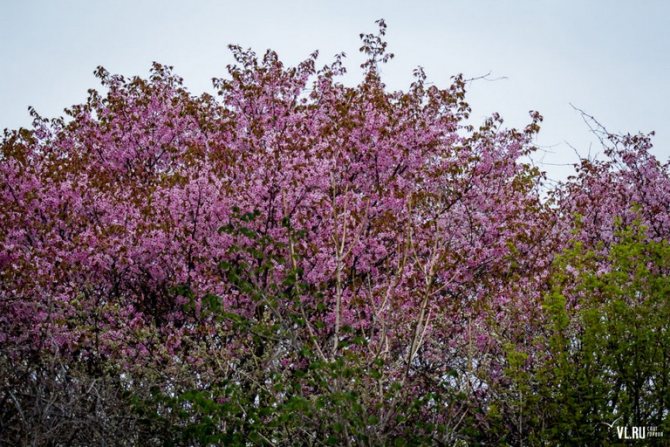

Another detail: sakura takes root slowly, and, especially in the first time after planting, it needs abundant watering - in dry weather from spring to July, weekly.
This is not to say that the Sakhalin beauty makes more demands than other trees. They are, of course, there - I'll tell you more.
Warm place
The place of sakura is in the front garden or in front of the gazebo, where you can admire it during flowering. At the same time, there it will be protected from strong winds. Sakhalin Sakura, despite its relatively high winter hardiness, in December-February suffers from sharp fluctuations in temperature, thaws, and sometimes in May - from late spring frosts.
An undesirable place is lowlands and depressions, where cold air accumulates and flood and near ground water stagnates.
Planting time - spring
Sakura is best planted in the spring, not in the fall. It is advisable to use a seedling with a closed root system. So the plant will have time to take root and adapt to new conditions before winter. For seedlings with open roots, the spring planting period is short - literally a few days (until the bud breaks).
When planted in October, cherries usually do not have time to take root in a new place and often die.
Correct landing pit
It is shallow - up to 40 cm, since the cherry roots are located rather superficially.They are not buried, the root collar should be 3-5 cm above the surface level of the site, taking into account the subsidence of loose soil.
The diameter of the pit is 70-100 cm. After placing the roots of the seedling there, the pit is filled with fertile soil with the addition of compost (completely rotted), evenly mixed with 500 g (full liter jar) of wood ash. As you know, it contains macro- and microelements necessary for the full development of cherries - everything except nitrogen, which is enough for plants for the first time.
Watering plentiful and regular
Immediately after planting, as in the following summer months, abundant and regular watering is essential. And better, rain, river or pond water, then the seedlings take root faster.
Disease protection
Any species and varieties of cherries, including Sakhalin, suffer from a fungal disease - moniliosis - and eventually weaken, freeze out. They have been amazed since May: spores from old neglected plantings are carried by wind and flood water.
What to do? In early spring (before bud break), the crown of trees and the soil under them are sprayed with a solution of 3% ferrous sulfate or Bordeaux liquid (30 g per liter), then during budding and immediately after flowering - with 1% of the same preparations.
Starting in June, as soon as the tips of the young growth branches begin to fade and dry out, they are immediately cut off and destroyed.
The main source of the disease remains on fallen leaves and damaged fruits - they are carefully collected and burned in the fall.
Nutrition for health
If the tree can be grown initially healthy, then such multiple spraying may not be needed. Plants will be strong if in the first half of the season they are fed 2-3 times with a weak solution of fertilizers, combining organic (for example, "Bucephalus", "Radogor", "Flumb-kuryak") with complex mineral fertilizers.
With such careful care, the northern sakura will not only not get sick or freeze, but it will bloom for a long time - up to two weeks. And throughout the season it will delight you with surprisingly beautiful foliage.
BRIEFLY ABOUT IMPORTANT
The sakura tree blooms for the third year after planting.
The plant is propagated by grafting on a regular cherry, as well as by rooting green cuttings, at the end of June.
It is important to process trees not only in your own garden, but also in neighboring ones, having agreed in advance.
Flowering time
Sakura bloom begins in January on about. Okinawa (located in the south) and ends at about. Hokkaido, thus moving north. The period when this tree blooms largely depends on its species: some plants begin to bloom in winter, others - at the end of spring.
For example, such well-known species as:
- Fuyu-Dzakura - blooms in the last month of autumn;
- Yama-dzarkura - early plant, blooms at the end of March;
- Someyoshino - in early April;
- Yae-zakura - in the middle of spring;
- Kasumi-zakura - in early May.
When the flower is fully open, it stays that way for about a week. How long it will bloom depends largely on the weather and temperature - the colder it is, the longer it will be possible to contemplate the sakura flowers. But strong winds and rain, on the contrary, will significantly reduce the flowering of sakura.
Sakura garden
The main varieties of sakura
Modern sakura varieties are created by crossing it with cherries (Cerasus yedoensis), (C. Lannesiana) and (C. Incisa). The most famous varieties:
- "Shirotae". The tree reaches a height of 4.5 m, the flowers are white, non-double. The variety is actively used in England and Japan. The birthplace of cherries is England.
- "Hally Tolivett". Frost-resistant variety with a ball-shaped crown. The flowers are 4 cm, pink in color, the diameter of the inflorescences is 8 cm. The tree is propagated by green cuttings.
- "Kwanzan". One of the most famous varieties. The flower contains 30 petals, the color is purple. Of the minuses - the tree does not differ in longevity.
- "Kikushidare-zakura". The tree reaches a height of 5 m. The flowers are double, pink, up to 6 cm in diameter. Of the minuses, the cherry is not able to withstand severe frosts.
- "Amonogawa". The height of the tree reaches 8 m, the width is only 1.25 m. The flowers are numerous, pink, fragrant.
Fallen sakura
Diseases and pests
| Cherry coccomycosis Symptoms:
Treatment:
|
| Cherry moniliosis Symptoms:
Treatment:
| |
| Cherry slimy sawfly Symptoms: In June-July, small dark slugs appear on the underside of the leaves, which feed on the sap of the tree. In a short time, the leaf dries up completely. Treatment: Slugs are destroyed with Piliton or Actellic. |
Description of the tree
Sakura is the name for the trees of the pink family, the plum subfamily (the species is small-sawn cherry), most of which perform a purely decorative function: they bloom, but do not bear fruit (unlike other trees of its kind, Japanese sakura is grown not for the sake of berries, but for flowers). There are 16 types of sakura and more than 400 varieties.
Despite the fact that cherry trees can be found mainly in the south of the northern hemisphere: in China, Korea, in the Himalayas, most of the trees of this species grow in Japan: nine out of sixteen species and a considerable number of varieties. There are especially many someyoshino (white sakura with huge flowers) and shidarezakura (weeping willow) - this sakura color has a pink tint. Sakura grows very well next to other plants of its kind, which, depending on how they were planted, make a different impression. For example, tree branches planted in parallel rows at the top can intertwine with each other, forming a flowering arch above your head - it looks especially gorgeous if at this time the flowers have already begun to gradually fall off and a person steps on the carpet that created sakura petals.
The height of the plant depends on its age, but usually it is about 8 meters (but there are also taller trees, for example, one of the oldest cherry blossoms in the world, whose age is 1800 years, has about 24 meters in height).


Spring trees
The bark is smooth, cut across the entire surface of the tree with small horizontal cracks of a gray, green or red hue, and the wood of the tree is very flexible due to the high amount of resin in it.
Leaves are oval or spear-shaped with slightly jagged edges. When a sakura branch blooms, it is completely covered with flowers, mainly white or pink, with each inflorescence consisting of several double flowers, usually having 5 petals. The Japanese managed to breed species, the flowers of which contain about 50 petals, the diameter of which is about 50-60 mm - outwardly they even resemble roses, peonies, chrysanthemums.
Sakura petals can be of different colors: white sakura and pink are often found, but you can often see flowers of red, crimson, yellow and even green and variegated tones. Since the sakura flowers bloom even before the sakura leaves appear on the tree, it seems as if a huge number of delicate inflorescences are stuck to the dead and bare trunk (therefore, the flowering period in Japan is also associated with rebirth).
When the sakura petals start to fade, but have not yet fallen from the tree, and the cherry blossom sprig is overgrown with the first leaves, the plant looks extremely elegant and summer-like (the Japanese call it Ha-Dzakura, which means "sakura with leaves"). Few trees of this species bear fruit, and if they do yield, the sakura (sakurambo) fruits are usually very small, cherry-colored, have a large stone, tightly covered with thin pulp, and taste very sour and tart. They are sold in small boxes and are extremely expensive.
Iron dregs between sakuras
Landing
Many gardeners of central Russia successfully grow this ornamental cherry on their plots. For her, you must definitely choose a place well-lit by the sun, because sakura is a fairly light-loving tree.
The best time for planting is spring, when a steady heat already appears, or late autumn. For more abundant flowering, it is recommended to plant several different varieties at the same time at a distance of 2 m from each other.
A mixture of humus and fertile soil is poured into the planting pit, then fertilizer is added - potassium and superphosphate, dissolved in 15 liters of water. After planting, the plant is watered and the area around the trunk is mulched with peat. In order for the plant to strengthen properly, this area should be kept clean in the future.
Gardeners reviews
Iren1
Sakura is a "made" variety of cherries with a DECORATIVE purpose .. not for the sake of fruits, but for beauty ... But, of course, there are cherries with fruits ...
Ruslan ... Just Ruslan
in the city of Alexandria, Kirovograd region. three or four cherry blossoms in the central square have been growing for 5-7 years, very large trees; when I got into the season, I saw how they bloom - a very beautiful sight
Sakura - planting and care in the open field
At the mention of the phrase "Japanese cherry" immediately from the depths of our memory pops up a vivid picture with sakura trees drowning in a lush pink bloom.
In Japan, sakura is traditionally considered a symbol of female beauty and youth; many beliefs and legends are associated with it. The flowering period of this plant is celebrated by the Japanese as a universal family holiday. At the beginning of the 20th century, decorative sakura cherries were brought to Russia by Professor Krasnov and planted in the Batumi Botanical Garden, later in the Sukhumi arboretum.
Read also: Avicolor breed of chickens - description with photo and video
Seed and soil preparation
You can't just take seeds and put them in the soil - you will not get the expected result. For the competent cultivation of sakura, compliance with certain rules and regulations will be required, including for the preparation of the soil and the seeds themselves.
During the period of working with sakura, gardeners have developed certain rules:
- Before directly planting seeds in the soil, place them in warm water for 24 hours. The temperature should be 25-30 degrees. During soaking, it is recommended to add some fungicide to the water, which contributes to an effective fight against fungal diseases. This is a serious threat to the development of the plant, therefore it is important to protect the tree at the earliest stage, when it is most vulnerable.
- The best option for sakura soil is coarse sand. So cherry seeds germinate rather quickly and guarantee good results. To accelerate growth, the seed coat can be pierced to facilitate germination of the sprouts. Be sure to disinfect the soil - this way you will eliminate possible organisms developing here and protect the seeds from damage by pests.
- At the stage of sowing seeds, fertilizers can be omitted - natural minerals in the soil and accumulated in the seed are quite enough at the first stage of growth.
- The sand is abundantly moistened before planting - for rapid growth, a large amount of moisture will be required. Special grooves of shallow depth are made in the sand, into which the seeds are placed. The distance between the seeding strips should not be less than 3 centimeters - plants can interfere with each other and limit themselves in development.
After placing the seeds in the soil, they are sprinkled with sand for additional protection and creating conditions for development. The top layer should be no more than double the diameter of the seed.
When and how it blooms
If you have ever been fond of Japanese folklore, then you may have noticed that during the winter holidays, sakura blooms profusely. The tree begins to bloom in January, but flowering does not occur evenly, but from South to North.
At the same time, it is difficult to say when the plant will begin to bloom in the middle lane, since it depends not only on weather conditions, but also on variation. There are species that bloom in late autumn, winter, early spring, or closer to June.
Let's talk about flowering. Sakura blooms with incredibly beautiful pink flowers. On each cluster, about 7–9 inflorescences are formed, which completely overlap the shoot. As a result, it looks like the tree turns into a huge ball.


Speaking about how many sakura blooms, it is worth noting that each flower lives no more than 10 days, after which it withers and crumbles. No re-bud formation occurs, so 1.5 weeks is the maximum flowering period.
Breeders have bred interesting species that throw out huge buds with 45-50 petals. From the outside, it may seem that the tree was decorated with rosebuds.
Important! The colder it is outside, the longer the tree will bloom.
How to grow a tree from seeds
Bonsai sakura, like other plants, can be grown by the seed method. True, this process is very difficult and very troublesome. As Since bonsai is formed over 15-20 years, home sakura will require a lot of patience.
Where to buy sakura seeds, how to grow a flowering plant at home - are of interest to many beginners and amateurs. After all, sakura is a plant with amazing flowering, and its formation in the form of a tree on a tray will be the most exciting activity.
Japanese cherry seeds are purchased in specialized garden centers, however, they appear there very rarely.
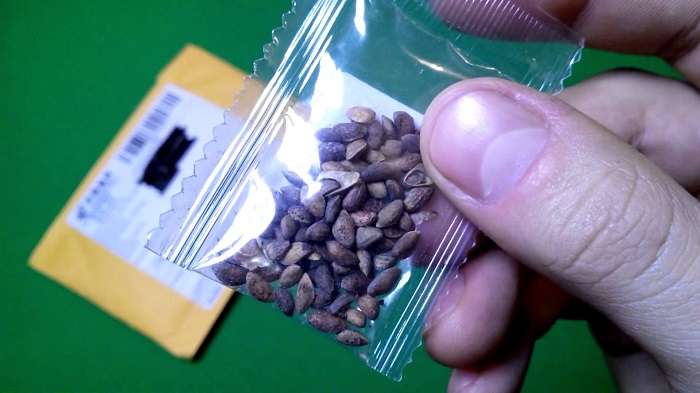

Advice! When sakura seeds are found, it is worth stocking up on planting material, since they sprout "infrequently and sparsely." According to the observations of professionals, out of 10 seeds only 1-2 germinate, that is, the germination percentage is 10-20%.
There is a technology on how to grow sakura from seeds at home:
- After purchase, each seed should be scarified (chipped, filed), since their shell is very strong.
- Place in warm water for 24 hours to swell.
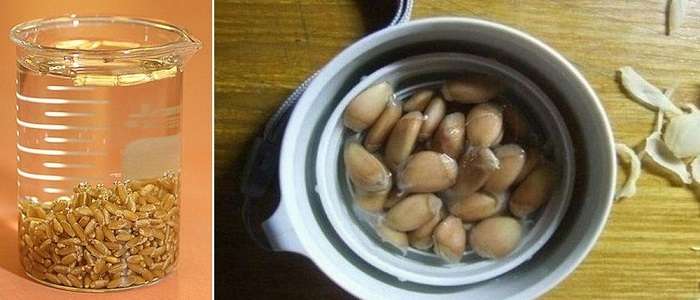

- After that - into moistened soil to a depth of no more than 2 cm.
- Cover the pot with plastic wrap and put it in a cold place (lower shelf of the refrigerator, cellar). The stratification period is 60-70 days.
- After the expiration of the "cooling" period, the flowerpot is placed in a bright place and kept at room temperature.
- When shoots appear, young specimens should be immediately transplanted into special bonsai plants - flat pots. With a group pick, the distance between young plants should not be more than 10 cm.
Important! The sakura plant comes in many varieties, each with specific characteristics and growing requirements. That is why, when buying seeds, it is recommended to study what kind of soil, watering and feeding regimes a particular variety of Japanese cherry prefers.
Sakura seeds are sown in April-May. The soil is used: a mixture of coarse sand, sphagnum moss, vermiculite. The first sprouts appear within 2 weeks after moving the flowerpots to the warmth.
The incomparable sakura bloom, a photo of which is presented on the network, pleases the eye much earlier than the appearance of leaves and other flowers in the garden. As a rule, already in April-May, the tree is densely covered with flowers up to 1 cm in diameter. The month of cherry blossom flowering depends on the climatic conditions of the region and the plant variety. Unfortunately, flowering is short-lived, but noble greenery replaces the beautiful pink cloud. And sakura again conquers with its appearance.
How to plant potted sakura is recommended by professionals. Despite the variety belonging to the species, young plants need picking. In addition, seedlings are transplanted every 3-4 years as they grow (in winter, the transplant is not performed - the plant is sleeping).
How to plant seedlings?
For the first two years, it is recommended to grow Japanese cherries in a pot. This is necessary so that she grows up and gets stronger.
For Togo to plant a seedling in open ground, you need to dig a hole twice as deep as the base of the seedling. Before placing it in the groove, the roots are carefully separated. About 7.5 cm is left from the base of the soil. This is necessary in order to raise the seedling above the ground.


It is better to choose a land that is weakly acidic or with neutral acidity. Add potting soil to the groove. Set up a tree and cover it with earth a little, forming a hill. Drizzle with a little water. Then sprinkle with soil again, tamp lightly. The roots must be firmly in contact with the ground.
After the seedling has been planted, you should drive a peg next to it and tie the stem to it so that the tree does not sway with the wind. Near the hole, you need to make a small groove and pour in a small amount of water there.
It is necessary to replant young plants every year. Adults - no more than once every 3-4 years. The topsoil must be changed every year. Sakura blossoms begin no earlier than 3-4 years of life under optimal conditions.
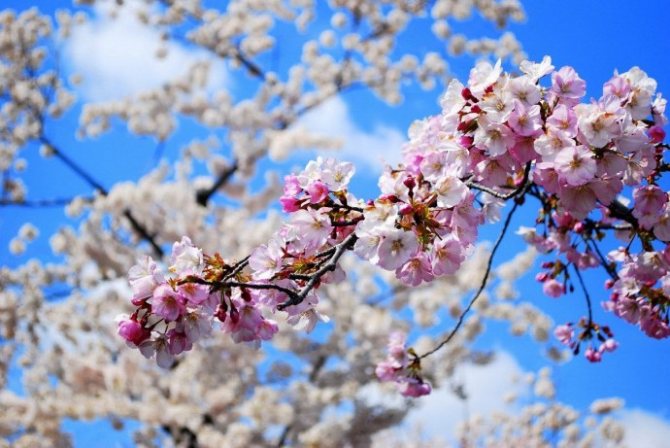

history of the holiday
The history of the holiday goes deep into the past. As the belief testifies, this custom originated in the period from the 8th to the 12th century. The Japanese nobility loved to spend time under the spreading flowering trees. She enjoyed the beauty of nature, composed poetry, drank drinks and played games. The aristocracy was distinguished by refined manners and grace. Its representatives attached great importance to flowering trees and saw a deep meaning in this. Gradually, the tradition became widespread and became part of the culture of Japan. It was sakura flowers that became a symbol of impeccability and perfection.
The most common types of sakura
Sakura is a generic name. It combines several species that are grown as ornamental plants, have small inedible fruits or do not bear fruit at all. There are over 600 varieties of cherry blossoms in Japan, including wild forms and hybrids.
In 1963, the book "Garden Plants of Japan" was published, compiled by dendrologists at the University of Tokyo. According to this publication, the following species belong to sakuras:
- mountain sakura (P. Jamasakura);
- Edos cherry (P. yedoensis);
- short-bristled cherry (P. subhirtella);
- sargent cherry (P. sargentii);
- ferruginous cherry (P. glandulosa);
- bell cherry (P. campanulata);
- finely sawed cherry (P. serrulata);
- sharply serrated cherry (C. serrulata).


Bell cherry (Prunus campanulata).

